#it’s those born between 2005-2013
Explore tagged Tumblr posts
Text
Mitch Thompson

Mitch Thompson isn't just a baseball coach; he's the head honcho of the Baylor Bears' batting lineup, and let's just say, I wouldn't mind if he coached me in more… intimate settings.



Born in Goodland, Kansas, Mitch's journey from Cloud County to Fort Hays State was more than just a path to becoming a two-time Academic All-American; it was the start of a journey that would make me want to slide into his DMs.
His coaching gig started at Mississippi State in 1990, where I bet he was turning heads with more than just his baseball strategies. After a brief, tantalizing detour at Radford University, he returned to Mississippi State, probably leaving a trail of broken hearts.
Joining Baylor in '95 as the hitting coach, Mitch didn't just hit home runs; he hit them out of the park in terms of success, leading to three Big 12 titles and a College World Series appearance in 2005. His recruitment skills? Legendary. He could probably recruit me into his bedroom with those stats.




Then, in 2013, he took over at McLennan Community College, turning it into a baseball behemoth with accolades that could make any academic swoon. But let's talk about that GPA – maintaining a 3.0 while being that hot? That's some next-level multitasking.





He returned to Baylor in 2022 as head coach, bringing with him a reputation that's as rock-hard as… well, you know where I'm going with this.


Married to Amber, with two daughters, Mary Conley and Caroline, both Baylor alumni. But let's be real, if I had to choose between watching a game or watching Mitch, I'd be in the stands, but for entirely different reasons.

So here's to Mitch Thompson, the man who could make me cheer for baseball, or anything else he's coaching, really. Keep swinging, Coach; you've got at least one very enthusiastic fan here, ready to learn any lesson you're willing to teach.
Head Coaching Record Overall 42–66 (NCAA DI) 372–138–1 (NJCAA) Tournaments: NCAA: 0–0
Accomplishments and Honors Championships: NJCAA National (2021) 4x Region 5 Tournament (15,17,21–22) 3x NTJCAC Regular Season (16–17,21)
135 notes
·
View notes
Text
OBITUARY
BOB BRYAR, FORMER DRUMMER OF MY CHEMICAL ROMANCE, DEAD AT 44
The musician performed with the rock band on The Black Parade and Danger Days after joining in 2004
By EMILY ZEMLER
NOVEMBER 30, 2024
Full article under the cut:

Bob Bryar of My Chemical Romance performs at Big Day Out Festival 2007 at the Sydney Showground. PAUL MCCONNELL/GETTY IMAGES
Bob Bryar, the drummer of My Chemical Romance from 2004 to 2010, has died at the age of 44, Rolling Stone has confirmed.
“The band asks for your patience and understanding as they process the news of Bob’s passing,” a spokesperson for the band tells Rolling Stone.
Details surrounding his death were not given, but law enforcement sources told TMZ the musician was found in his Tennessee home, and no foul play is suspected. The medical examiner is investigating the cause of Bryar’s death.
Born in Chicago in 1979, Bryar started playing drums at a young age and got a degree in sound engineering from the University of Florida before becoming a touring sound engineer. He worked for Thrice and the Used and met My Chemical Romance while on tour with the Used in 2004.
Later that year, My Chemical Romance replaced drummer Matt Pelissier shortly after the release of the New Jersey rock band’s second LP, Three Cheers for Sweet Revenge. He went on to perform on three of the band’s subsequent releases, including their seminal 2006 album, The Black Parade, and their 2010 effort, Danger Days: The True Lives of the Fabulous Killjoys.
“This was the biggest record I have ever done and I was nervous,” Bryar recalled of recording The Black Parade in an interview with Alternative Press. “Along with being nervous, we all had to feel out the writing dynamic between all of us. I was very vocal about my drum parts, but let the other dudes do their thing because they were doing so well and didn’t need anyone chiming in every second. That leads me to remember one situation where it was super-late and only G, the engineer and myself were at the studio. There was a vocal harmony that I kept hearing. It was the first time I got the balls to ask someone to try something. That idea made it to the record, which was really nice for me to see happen.”
He added, “As we were recording the record, I was getting more and more excited. It was turning out to be a very complete and a very entertaining audio story… I really feel every part of that record, down to the artwork, is pretty unbeatable. I hope those songs will be around for a long time.”
Bryar departed from My Chemical Romance, who later disbanded in 2013, following the release of Danger Days, although he performed on the band’s singles collection, Conventional Weapons. Band member Frank Iero confirmed in a statement that Bryar’s exit was “a painful decision for all of us to make and was not taken lightly.” He added, “We wish him the best of luck in his future endeavors and expect you all to do the same.”
My Chemical Romance replaced Bryar from 2011-2013 with Jarrod Alexander, who also joined the band for their 2022 reunion tour. After leaving the band, Bryar continued to tour behind the scenes with various bands and became involved in dog rescue charities and sanctuaries. In 2014, he quit the music industry to pursue a career in real estate.
In 2021, Bryar auctioned off the drum kit used during the band’s 2005 MTV VMAs performance to raise money for the Williamson County Animal Control and Adoption Center in Tennessee. “It’s my favorite finish of all of the kits I’ve had,” he wrote of the set. “If you look closely, there is still some confetti from tour that snuck into the bass drum hole. I’ll leave that in there for you.” In 2022, Bryar announced he would be selling his original Black Parade uniform to help “abandoned and sheltered animals in areas of Florida and South Carolina that are affected by Hurricane Ian.”
END
#mikey way#bob bryar#mcr#rolling stone#live#lltbp#bp#2024#nov 2024#11/30/24#11/29/24#2007#text#photo#originals
27 notes
·
View notes
Text
matthew lore: childhood friends & teammates
AKA a vaguely chronological list of current NHL players Matthew knew before he ever played an NHL game
This is already a massive list, so in an effort to keep it as short and organized as possible, I have bolded the names of guys who appear in multiple categories and have only included those who have played at least a full season’s worth of games in the NHL.
For a comprehensive list of his teammates that have ever played an NHL game, this invaluable tool will provide you that information dating back to his first season in the NTDP (2013-2014).
CASEY FITZGERALD gets to go first and uncategorized, because he’s known Matthew longer than anyone else on this list, seems to be the cousin he’s closest to, and is one of the three childhood teammates that became one of Matthew’s NHL teammates. (And roommate!)
THE ST. LOUIS BOYS
LUKE KUNIN is THE guy. Their families are friends (Matthew’s whole fam was at Luke’s wedding, Luke’s whole fam was at Brady’s), and they were teammates for fourteen straight seasons before finally getting separated after their time at the NTDP, which is so long Luke's literally known Matthew longer than Taryn has.
Of the six St. Louis guys drafted in 2016, Luke and Matthew were the only ones born in 1997, so the following have all played with Matthew significantly less than Luke.
CCM Motown Classic 2005

TRENT FREDERIC From what I can find, Trent only played with Matthew during the 2005-2006 St. Louis Rockets season, but he played with Brady and was coached by Keith in the same Junior Blues hockey program, was one of the family friends that got to come around and play mini sticks with David Backes as a kid, and his time at the NTDP overlapped with Matthew’s in the 2014-2015 season (Trent U17, Matthew U18).
2010 Quebec International Pee-Wee Hockey Tournament

CLAYTON KELLER played in the 2010 Quebec International Pee-Wee Tournament with Matthew and likely more but trying to find youth hockey rosters from before 2015 is a herculean task. But he was one of those U17 guys that got to play up with the U18s his first year in the NTDP and played with Matthew for 16 games and then went on to win gold together at the U18 Men's World Championship in 2015.
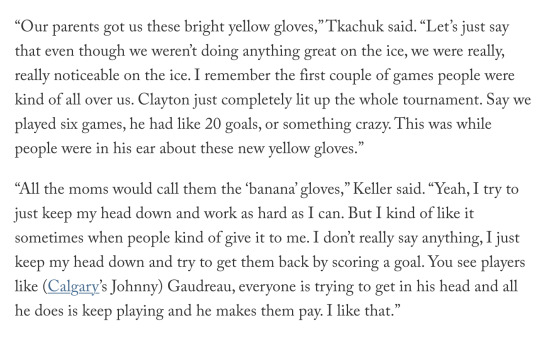
LOGAN BROWN Other than the 2010 tournament, Logan seems to have played more with Brady than he did with Matthew, and wasn’t in the NTDP like the other guys, but does train with them in the summer.
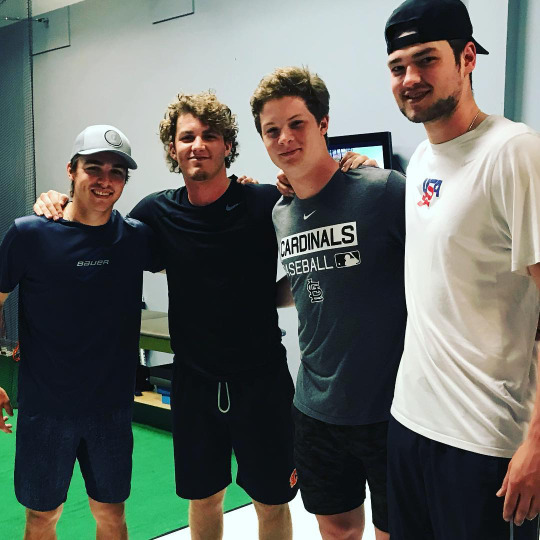
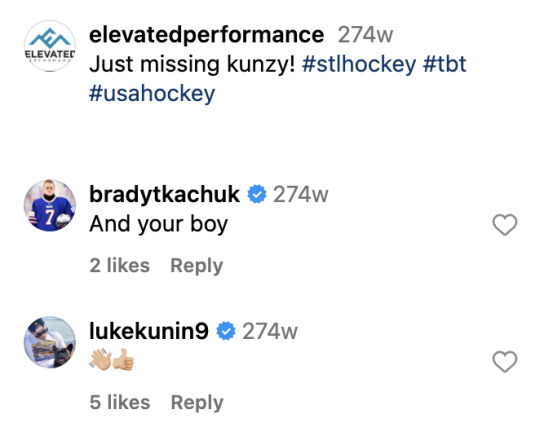
2011-2012 U15 AAA Junior Blues Team

2013 U16 National Tier One tournament champions

JOSEPH WOLL Unlike the other St. Louis boys, Joseph seems to have played exclusively with Brady, but his time at the NTDP overlapped with Matthew’s the same as Trent’s did. It’s unclear if he trains at the same place as the others during the offseason, but along with the rest of the 2016 St. Louis Draftees, his signed draft day photo is framed in Matthew’s bedroom at his parents' house because of course it is.
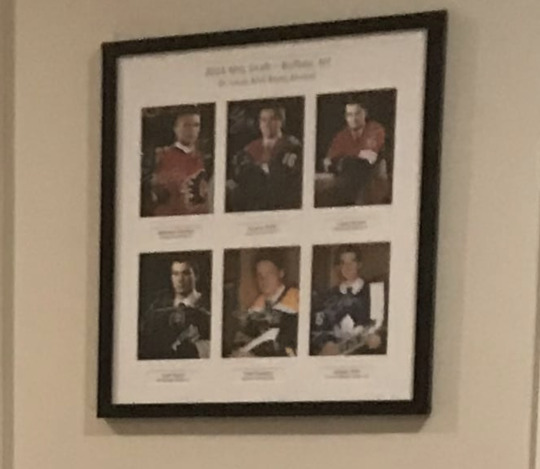
THE 1997 JUNIOR BRUINS
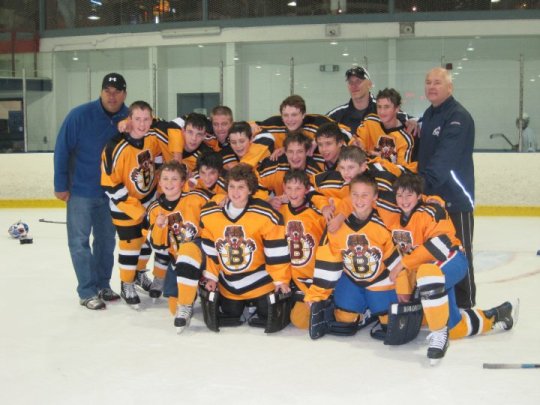
This Athletic article is about all the NHL players who played for the 1997 Junior Bruins tournament team over the years, but from what I can find, Matthew only played on the 2010 team with Casey Fitzgerald, NOAH HANIFIN, CHARLIE MCAVOY, COLIN WHITE, and the ever present, Luke Kunin.
Matthew is still close friends with all these guys, but Noah in particular is a Noted Best Friend and with him being from Boston and the Tkachuks having a house in Cape Cod, their summers overlap a lot even when they aren’t teammates.
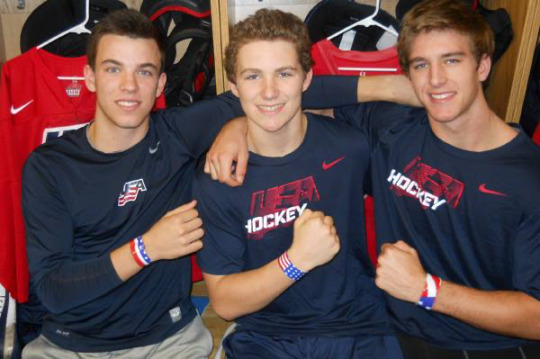
With Casey, he and Colin White are the only childhood teammates to play with Matthew in the NHL.
THE NTDP BOYS
Okay, this section is where it gets a little chaotic so I split it between the guys who played with Matthew and those he went to school and was familiar with because their time at the NTDP overlapped.
2013-2014 NTDP Teammates Including the gold medal teams for the 2014 U17 World Hockey Challenge & the 2015 U18 World Championship
ZACH WERENSKI
Repeat: Noah Hanifin
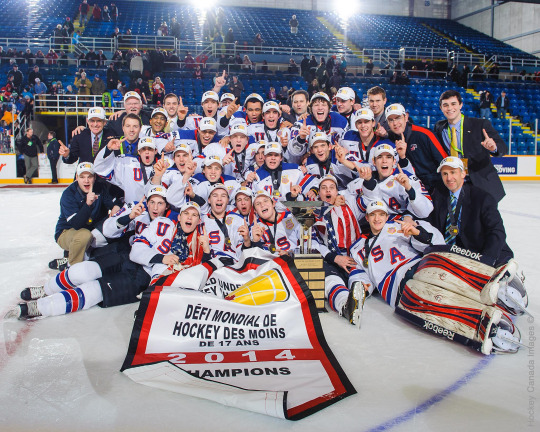
2013-2015 NTDP Teammates Including the gold medal teams for the 2014 U17 World Hockey Challenge & the 2015 U18 World Championship
JORDAN GREENWAY
CALEB JONES

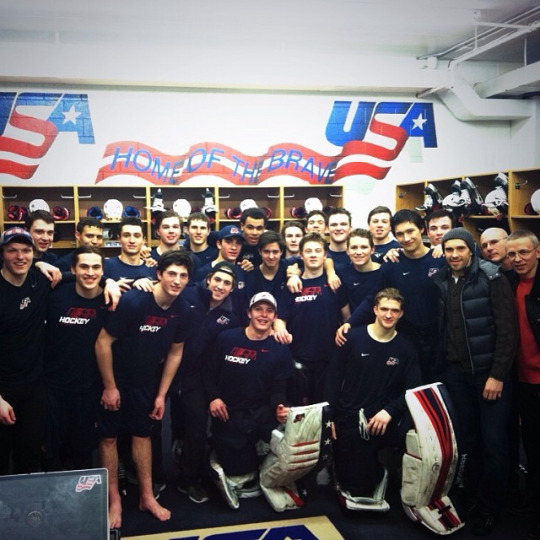
CHRISTIAN FISCHER spent his youth hockey years playing against Matthew, and when they both headed off to the NTDP, their parents split billet duties. He is one of Matthew’s best friends, attended Matthew’s draft, and even went with Matthew to Brady’s draft.

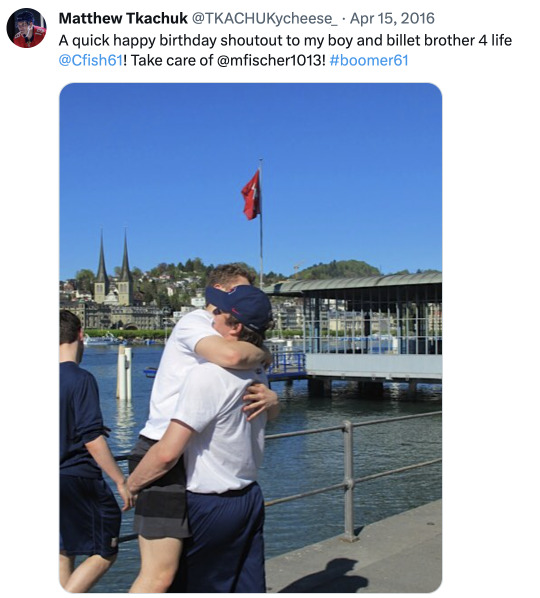
JACK ROSLOVIC was linemates with Matthew (and Auston) in the 2014-2015 season and when Matthew went to the 2015 Draft to support all his 1996 boys, Jack was the one he chose to sit with. The next summer, Jack returned the favor (see photo with Christian at Matthew's draft above).
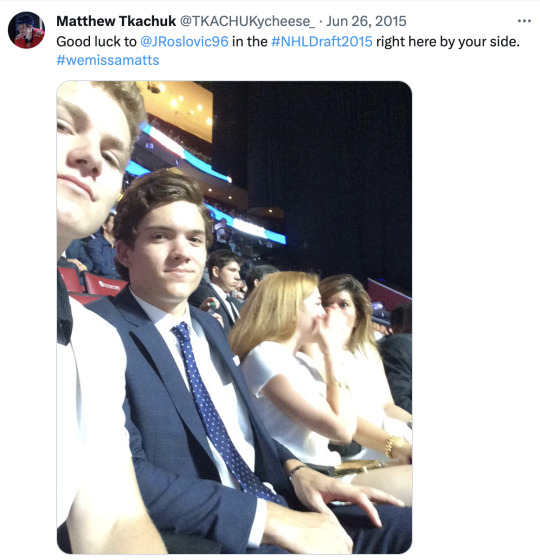
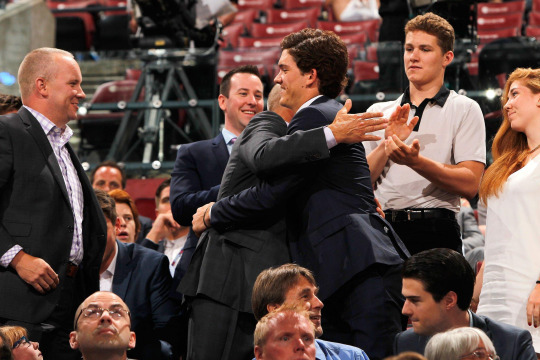
AUSTON MATTHEWS is another family friend. He was Matthew’s center in 2014-2015 and when he broke his leg the previous year, Keith got a bunch of NHL guys to reach out to Auston , and he’s the one who gave us the best story about Matthew texting his own highlights to his friends.
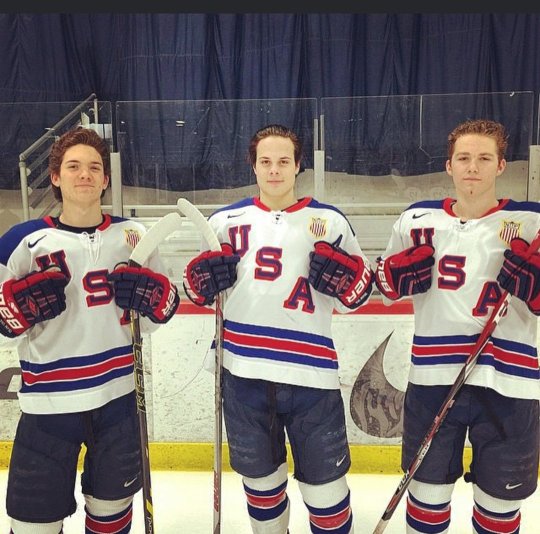
Repeats: Luke Kunin, Casey Fitzgerald, Colin White, Charlie McAvoy
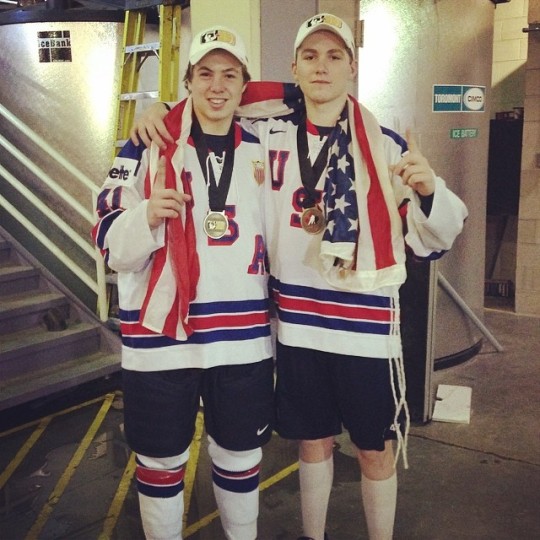

2014-2015 NTDP Teammates Including the 2015 U18 World Championship
TAGE THOMPSON
TROY TERRY
Repeat: Clayton Keller: played up 16 games as a U17
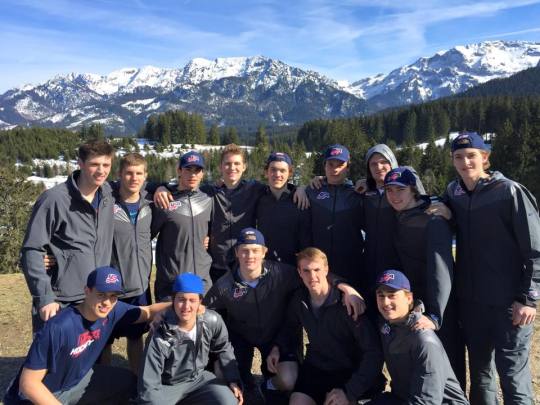
Teammates for a handful of games:
TOMMY NOVAK: 2 games for 2013-2014 U17 team
JAKE OETTINGER: 3 games for 2014-2015 U18 Team, and was part of the team but did not PLAY in the 2015 U18 World Championship
MAX JONES: 2 games for 2014-2015 U18 TeamRYAN DONATO played 4 games for 2014-2015 U18 Team and is now part of the extended Tkachuk family due to Emma, Brady’s wife, being his cousin.
NTDP Overlaps
2013-2014 U18s:
JACK EICHEL
ALEX TUCH
DYLAN LARKIN
2014-2015 U17s:
JOEY ANDERSON
ADAM FOX
RYAN LINDGREN
KAILER YAMAMOTO
repeats: Max Jones, Clayton Keller, Joseph Woll, Trent Frederic, Jake Oettinger

2015-2016 LONDON KNIGHTS
ROBERT THOMAS is practically a third Tkachuk brother at this point. But before Robbie lived with the Tkachuks, his own parents opened their home to Matthew while he trained at Gary Roberts’ the summer of his draft. Then when Robbie’s rookie season came along, it was Matthew who then suggested Robbie live with his parents too.

MITCH MARNER
EVAN BOUCHARD
VICTOR METE
Repeats: Max Jones, Christian Dvorak
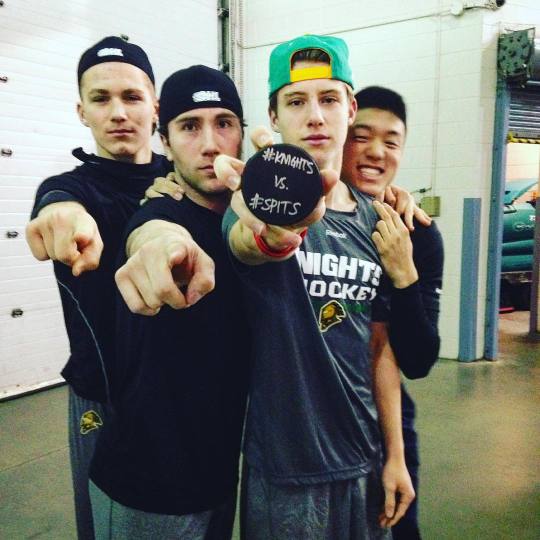
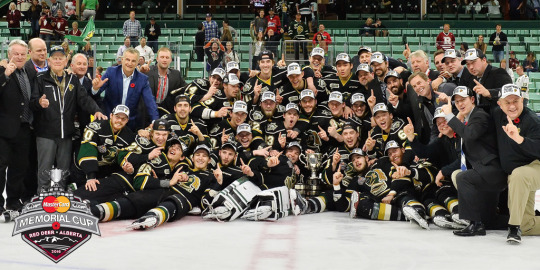
2016 WORLD JUNIORS (bronze medal team)
NICK SCHMALTZ
BRANDON CARLO
BROCK BOESER
WILL BORGEN
ALEX DEBRINCAT
ANDERS BJORK
ALEX NEDELJKOVIC
SONNY MILANO
Repeats: Auston Matthews, Zach Werenski, Christian Dvorak, Colin White, Ryan Donato, Charlie McAvoy

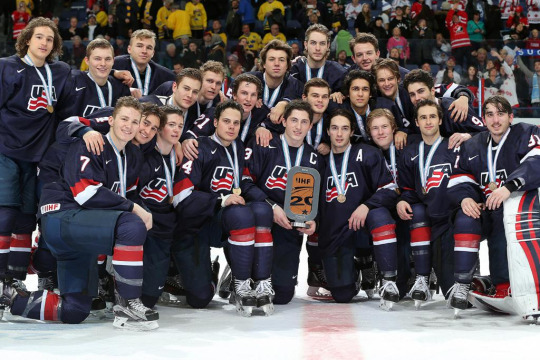
HONORABLE MENTIONS
None of the Hughes brothers played with or overlapped with Matthew in the NTDP, but the two families are friends, and as far as I can tell, first met in 2010 when Quinn played on Brady’s Junior Bruins tournament team.
QUINN HUGHES is Brady’s best friend from billeting with him and Keith while in the NTDP and is on this list because Jack called Brady and Matthew QUINN’S BOYS, their families are friends and met at the latest, in 2010 when Quinn played on Brady's Junior Bruins tournament team. On top of that, Quinn he once included Matthew in his answer about watching Chris Tanev play after he got traded to the Flames for no reason at all other than to say he likes to watch him play too.

And last, but certainly not least, is CONNOR MCDAVID.
Matthew spent multiple summers, including the summer before his rookie season, training with Connor at Gary Roberts’ and the two of them are what I like to call STAR CROSSED TEAMMATES. Not only does Matthew swear the Oilers almost drafted him—and there’s certainly enough reports and predictions from before his draft to back up that being the plan—but Connor could’ve been a 1997 Junior Bruin if Brain McDavid wasn’t out to get me.
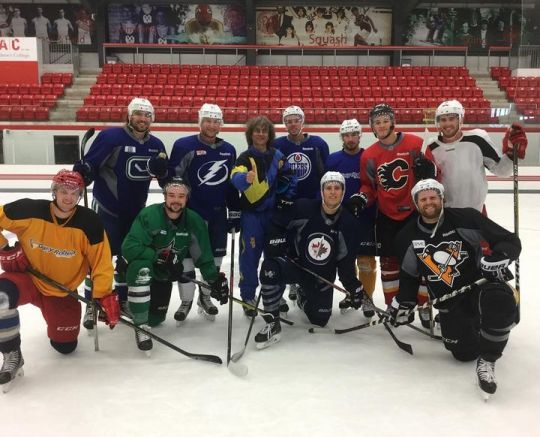

#matthew lore#matthew tkachuk#i am not tagging every guy in this it's just too many#rip to all the photos i curated for this post that could not fit
255 notes
·
View notes
Text
Like millions of others who lived behind the Iron Curtain, I grew up in the Soviet Union viewing America as a beacon of hope. The difference between free and unfree was readily apparent to me as a young player on the international chess scene, and I began to use my platform to protest repressive practices back home. When I retired from professional chess in 2005, I channeled all of my energy into preventing Russia from sliding back into the hands of the KGB, the Soviet Union’s secret police and most sinister spy agency. Unfortunately, those efforts were unsuccessful: Vladimir Putin consolidated power and rebuilt an authoritarian state in the image of the Soviet regime under which I was born. Facing imminent arrest, I was forced into exile and have lived in New York since 2013. I never thought I would need to warn Americans about the dangers of dictatorship.
Donald Trump has been breaking down the guardrails of American democracy for nearly a decade now. Generations to come will reap the consequences. His presidency—and his three campaigns for the office—have demonstrated that the institutions so many of us took for granted are, in large part, based on custom and tradition, not written law. As Ronald Reagan famously said, freedom is “never more than one generation away from extinction.” The political system we hold dear is deeply fragile, and depends on our constant commitment to uphold it.
Trump hasn’t even won the election yet—and his victory is far from assured—but we are already seeing signs of preemptive obedience that should look familiar to many refugees from repressive regimes like me. Both the Washington Post and Los Angeles Times canceled endorsements of Vice President Kamala Harris earlier this month at the behest of their owners, a de facto silencing of two major national newspapers. It should come as no surprise that business owners are careful to avoid upsetting someone who has frequently called for his detractors to be locked up, or in the case of Liz Cheney, have guns “trained on her face.”
Given my experience, I am not willing to stand idly by and watch the beacon of hope that I am grateful to now call home slide into the authoritarianism of my childhood. This election is a choice between a candidate who has vowed to fight for America’s institutions, and one who is deeply dangerous—a candidate who I believe will bring total mayhem and destruction to this country.
I want to speak, now, more specifically about Kamala Harris.
I have never been shy about criticizing administrations, regardless of party. I harshly condemned Barack Obama’s foreign policy—from his fecklessness in Syria to his dangerous Iran deal—as well as George W. Bush’s naivete when he claimed to have seen Putin’s soul after peering into his eyes. My criticism of both Trump and Joe Biden has been far from quiet. Only 28 percent of Americans today believe the country is moving in the right direction, and I understand their frustrations. While the situation at home certainly raises concerns, the geopolitical landscape is disastrous; the worst I have seen in my living memory. America’s prestige abroad is disintegrating. No wonder, then, that Trump’s hate-filled rhetoric is finding purchase.
But the role of the president and the vice president is not the same. With the notable exception of Dick Cheney (and perhaps Mike Pence when it counted the most), no vice president in recent memory played any meaningful role in setting policy. They do not hold the same responsibility as their boss for the direction the country takes. Biden essentially functioned as Barack Obama’s messenger, because his main task as vice president for eight years was to carry out and effectively communicate Obama’s vision—not his own. The same has been true of Kamala Harris for the last four years; her job has been to further Biden’s agenda, not her own. Consequently, J.D. Vance’s constant refrain—as vice president for nearly four years, Harris owns Biden’s policies—doesn’t make sense. It wasn’t Harris’ job to put her ideas into practice. And while she initially hewed closer to the administration’s stance, she has since stepped out from her boss’s shadow, making clear in interviews and on the campaign trail that she will not just follow in Biden’s footsteps. The policy proposals she is offering, whether you agree with them or not, are her own.
In an area particularly close to my heart—foreign policy—Harris’ agenda would represent an improvement from the status quo. Biden has spent many of his 40 years in government during a time when the threat of nuclear war was high, and that experience has undoubtedly informed his approach to foreign policy as president. Harris, on the other hand, doesn’t carry the same Cold War baggage, and has said that she would not allow Ukraine to succumb to Russian aggression. I don’t believe her administration would continue the Biden administration’s policies of betrayal when it comes to Ukraine—and Trump and Vance have obviously made no secret of their plans to essentially give in to Putin’s desire to swallow Ukraine.
Because Harris hasn’t been on the foreign policy scene for decades, my prediction is that she will hew closely to public opinion, which is currently oriented around a consensus that America should stand up to dictators. And on the domestic front, as a new president interested in being reelected—and likely constrained by a divided Congress and conservative Supreme Court majority—Harris would be unlikely to make waves and institute radical progressive policies.
Were Harris up against a Republican other than Trump, disagreements over her limited price controls, tax policy, or stance on social issues might constitute strong arguments against electing her. In this race, however, these arguments are moot. If you disagree with her policies, start challenging her the day after the election. I certainly will.
This election is bigger than policy, as the long list of prominent Republicans who are willing to stand up and support Harris demonstrates. Former Vice President Dick Cheney and his daughter, Liz; former California Gov. Arnold Schwarzenegger; former Sen. Jeff Flake; several members of Trump’s own administration, including some of the most senior. Many still align with Republicans on policy issues—some, in the case of Reps. Cheney and Adam Kinzinger, even voted for Trump in 2020. Unlike sycophantic outcasts like Robert F. Kennedy Jr., who made the reverse journey from the Democratic Party to endorse Trump, these are true, dyed-in-the-wool Republicans.
Legally, we have a choice in this election, but morally, the answer is clear: If we want to preserve America’s institutions and its standing on the world stage, we must elect Kamala Harris on November 5.
Ultimately, I am cautiously optimistic about a Harris presidency. She has the opportunity to normalize a deeply fractured political climate, to bring together the center-left and center-right under a banner of creating real opportunity for all Americans. I look forward to challenging her when we disagree, which I imagine will be often. But if her opponent is elected, the very institutions and traditions that guarantee our right to freely disagree would be under threat. Anyone who has lived in the Soviet Union or in Putin’s Russia will tell you what it’s like to fear publicly condemning the government. In Trump, I hear echoes of Soviet leaders past and Russian leaders present. Kamala Harris’ election is the only way to preserve democracy, at home and abroad. She may not be the best choice. But on November 5, she is the only one.
23 notes
·
View notes
Text
'Writer and poet Benjamin Zephaniah has died aged 65, after being diagnosed with a brain tumour eight weeks ago.
A statement posted on his Instagram account confirmed he died in the early hours of Thursday.
The statement said Zephaniah's wife "was with him throughout and was by his side when he passed".
"We shared him with the world and we know many will be shocked and saddened by this news," it added.
Zephaniah was born and raised in Handsworth, Birmingham, the son of a Barbadian postman and a Jamaican nurse. He was dyslexic and left school aged 13, unable to read or write.
He moved to London aged 22 and published his first book, Pen Rhythm.
His early work used dub poetry, a Jamaican style of work that has evolved into the music genre of the same name, and he would also perform with the group The Benjamin Zephaniah Band.
As Zephaniah's profile grew, he became a familiar face on television and was credited with bringing Dub Poetry into British living rooms.
He also wrote five novels as well as poetry for children, and his first book for younger readers, Talking Turkeys, was a huge success upon its publication in 1994.
On top of his writing work, Zephaniah was an actor and appeared in the BBC drama series Peaky Blinders between 2013 and 2022.
He played Jeremiah "Jimmy" Jesus, appearing in 14 episodes across the six series.
Zephaniah famously rejected an OBE in 2003 due to the association of such an honour with the British Empire and its history of slavery.
"I've been fighting against empire all my life, fighting against slavery and colonialism all my life," he told The Big Narstie Show in 2020.
"I've been writing to connect with people, not to impress governments and monarchy. So I could I then accept an honour that puts the word Empire on to my name? That would be hypocritical.
He often spoke out about issues such as racial abuse and education.
When he was younger, Zephaniah served a prison sentence for burglary and received a criminal record.
In 1982, Zephaniah released an album called Rasta, which featured the Wailers' first recording since the death of Bob Marley.
It also included a tribute to the then-political prisoner Nelson Mandela, who would later become South African president.
In an interview in 2005, Zephaniah said growing up in a violent household led to him assuming that was the norm.
He recalled: "I once asked a friend of mine, 'What do you do when your dad beats your mum?' And he went: 'He doesn't.'
"I said, 'Ah, you come from one of those, like, feminist houses. So, what do you do when your mum beats your dad?'"
In 2012, he was chosen to guest edit an edition of BBC Radio 4's Today programme.
Zephaniah was nominated for autobiography of the year at the National Book Awards for his work, The Life And Rhymes Of Benjamin Zephaniah, which was also shortlisted for the Costa Book Award in 2018.
During a Covid-19 lockdown, Zephaniah recited one of his poems in a video for the Hay Festival.
"Benjamin was a true pioneer and innovator. He gave the world so much," the statement announcing his death said.
"Through an amazing career including a huge body of poems, literature, music, television and radio, Benjamin leaves us with a joyful and fantastic legacy."
A statement from the Black Writers' guild, which Zephaniah helped establish, said: "Our family of writers is in mourning at the loss of a deeply valued friend and a titan of British literature. Benjamin was a man of integrity and an example of how to live your values."
Others paying tribute included author Michael Rosen, who said: "I'm devastated. I admired him, respected him, learnt from him, loved him. Love and condolences to the family and to all who loved him too."
Actress Adjoa Andoh posted: "We have lost a Titan today. Benjamin Zephaniah. Beautiful Poet, Professor, Advocate for love and humanity in all things. Heartbroken. Rest In Your Power - our brother."
Peaky Blinders actor Cillian Murphy said in a statement: "Benjamin was a truly gifted and beautiful human being.
"A generational poet, writer, musician and activist. A proud Brummie and a Peaky Blinder. I'm so saddened by this news."
Broadcaster Trevor Nelson said: "So sad to hear about the passing of Benjamin Zephaniah. Too young, too soon, he had a lot more to give. He was a unique talent."
Singer-songwriter and musician Billy Bragg added: "Very sorry to hear this news. Benjamin Zephaniah was our radical poet laureate. Rest in power, my friend."
Comedian, actor and writer Lenny Henry said: "I was saddened to learn of the passing of my friend Benjamin Zephaniah. His passion for poetry, his advocacy for education for all was tireless."
Writer Nels Abbey said: "To call this crushing news is a massive understatement. He was far too young, far too brilliant and still had so much to offer. A loss we'll never recover from."
The X/Twitter account for Premier League football club Aston Villa, whom Zephaniah supported said everyone at the club was "deeply saddened" by the news.
"Named as one of Britain's top 50 post-war writers in 2008, Benjamin was a lifelong Aston Villa fan and had served as an ambassador for the AVFCFoundation. Our thoughts are with his family and friends at this time."'


#Benjamin Zephaniah#The Benjamin Zephaniah Band#Peaky Blinders#Cillian Murphy#Adjoa Andoh#Michael Rosen#Black Writers Guild#Hay Festival#The Life And Rhymes Of Benjamin Zephaniah#Jeremiah “Jimmy” Jesus#Rasta#Pen Rhythm#Aston Villa#Nels Abbey#Lenny Henry#Billy Bragg#Trevor Nelson
37 notes
·
View notes
Text
─ 🎬 ( AMBER GRAY, 37, CISWOMAN SHE/HER. ) Have you heard of PAIGE STALLWORTH yet? i believe they’ve been living in LA for 12 YEARS. they’re currently working as a PERSONAL ASSISTANT TO VALERIE SINCLAIR in the movie. somethings that remind me of them are: CHECKLISTS CAREFULLY TICKED OFF, A NEVERENDING HAND BAG, A LISTENING EAR AND TRUSTED HEART, SEEMINGLY PERFECT AND READY TO UNRAVEL, ALWAYS TRYING BUT NEVER REWARDED. before joining this project, i’ve heard they were known for being ADAPTABLE, ORGANISED, AND MATERNAL. however, on the down side, they’re also known to be STUBBORN, PROMISCUOUS, AND BLUNT. because of this, they’re often labeled as THE RELIABLE. i just hope they come to set prepared. especially since I’ve heard those call times are going to be pretty early!

— BASICS
Name: Paige Stallworth Age / D.O.B.: 37 / 17th of September 1987 Gender, Pronouns & Sexuality: Cis woman, She/her & bisexual polyamorous Hometown: Freetown, Sierra Leone Job position: Personal Assistant to Valerie Sinclair Education: High School level Relationship status: Longterm polyamorous triad Children: Nonbiological sons aged 4 and 1. Positive traits: Loving, organised, loyal, adaptable, maternal Negative traits: Promiscuous, cold, stubborn, sarcastic, secretive
— BIOGRAPHY
tw: slight bullying mention, adoption difficulties, infertility
1987 - Paige is born. Not much is known from her early years only that she was born in Freetown and left at an orphanage at only a few months old.
1994 - She is adopted by the American family of the Stallworth's. They moved her to Georgia where she met her elder sister and extended family for the first time.
1998 - Paige starts Middle School. It’s a big adjustment and she shrinks back in herself a little. Still having tints of her original accent she’s bullied. Nothing horrendous but enough that she feels shy and anxious. She wants to cling to her sister but the older sibling finds it embarrassing and this is the start of the gap between them growing.
2005 - She graduates high school and the tensions between her and her sister are high. Paige’s grades were not what she wanted them to be and she becomes the first in generations not to go onto higher education. She gets a rubbish little job at a cafe and a bedsit
2013 - With little else but a dream and some savings Paige takes a chance and moves out all the way to Los Angeles She loved writing and had dreams of becoming a script writer. She quickly realises it's going to be very difficult and starts taking PA jobs to help supplement an income of freelance writing.
2016 - Paige meets Aikira. They start off as friends but it soon develops into something more.
2018 - Paige meets Philip whilst out with Aikira. There’s an instant connection between the three of them. Paige had been in polyamorous relationships but not with all three dating each other. It took a lot of deep conversations and clear boundaries but the three of them have been in a committed relationship since then.
2020 - The partnership's first child is a complete surprise and Paige finds herself on the outside of the experience. She tells herself she doesn’t mind that and truly as soon as she feels the baby kick for the first time she is smitten. Motherhood is something she didn’t know she wanted and she is besotted by her children.
possible fertility issues tw
2022 - When their eldest turned 2 the family decided to try for another child. Initially the plan was that Paige would carry the baby. However, after routine tests she was told it would be difficult for her to concieve. Not impossible, but difficult. The news broke Paige’s heart as much as she tried to hide it. The three of them decided to take a more casual approach agreeing that if something was to happen then itwould be a blessing but they didn’t want to put pressure on it.
2023 - Her partner, very worriedly, told Paige they were pregnant again. Paige was delighted to be a mother again but she has hidden a lot of her upset that she’s not been able to have that side of the experience yet. She’s tried not to let her partners see this and obviously adores her second son just as much as the first.
Now - Paige is happy (mostly) in her life. She works hard at her job, finds the organisation soothing in a way. Still writes on the side but she doesn't have much confidence in her own work. Cheeky, excitable once you know her she can initially come across as aloof or cold.
— WANTED CONNECTIONS / PLOTS
Taken by @28recsons (Philip) and @brokenbeauties (Aikira) Her partners - Paige and these two others have been in a relationship for the last 7 years (at least). They have two young sons together and are deeply loving and supportive of each other.
Her adoptive sister - They have an estranged and competitive relationship. UTP if your muse is the biological child of the Stallworths or also adopted.
2 notes
·
View notes
Note
As someone who mostly grew up with the 2005 series and only watched the movies and a few early episodes from the '79 series, what specifically makes the new series so much worse in terms of art or writing (it seems to be general consensus that the '79 series is much better).
i don’t know if it’s the general consensus but it’s what i always say. however, when i claim that, i’m usually referring to the episodes from the 80s, 90s and early 2000s, not the first episodes that aired in 1979 and 1980. in my opinion, ōyama doraemon is better than the 2005 series for the following reasons:
the art style; i personally think the one they used in the 90s and early 2000s was way better than the new one, which looks cheap in comparison (despite looking more like the manga but i really don’t care).
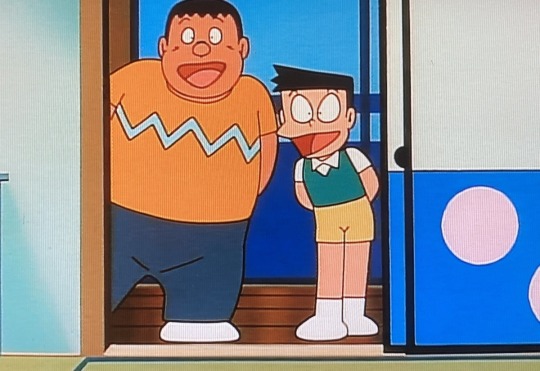

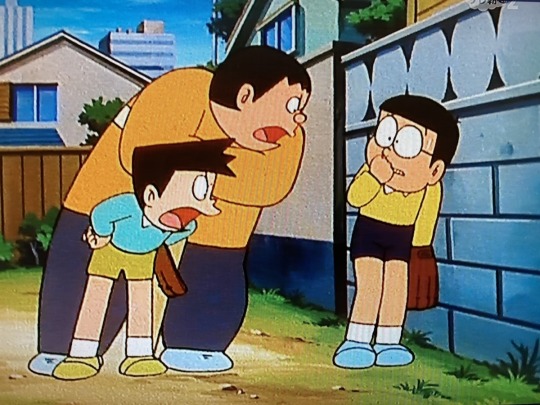



the nostalgia; you said you didn’t but i grew up with ōyama doraemon (which aired between 2003 and 2013 in italy, and i was born in 2005) and maybe this played a role in why i prefer this version, and the same thing probably happened to others as well. doraemon was a big part of my childhood and i remember quitting watching it as soon as they started airing the new one.
the retro vibes; i love the 80s and 90s vibes from ōyama doraemon. i can’t claim it as “nostalgic”, as that’s my parents’ childhood and not mine, but rather “interesting” for those who are into retro stuff. technology also wasn’t as developed as it is nowadays, so it’s fun to see what people from the 20th century thought 22nd century technology will be like. now we got artificial intelligence, so many gadgets aren’t as impressive to us as they were to someone who watched doraemon 30 years ago. first example that comes to mind is the episode where nobita wants to write a love letter to shizuka and uses a pen who does it for him.
the writing; the 2005 series sometimes feels like a parody of the 1979 one. the old series is funnier and has also more emotional moments i think, while the new one feels blander overall, to me.
13 notes
·
View notes
Photo

When is the best time to have a second, third, or even fourth baby? Well, every couple should determine that for themselves — some plan back-to-back pregnancies if infertility is a worry or they envision their children close in age; some space out their pregnancies to either savor each stage of the baby years or give themselves time to get used to being a fuller family. But if you ask science, there is a good time to plan a subsequent pregnancy. According to the Mayo Clinic, waiting 18 to 24 months — but less than five years after a live birth — is the healthiest gap in between pregnancies to avoid problems like premature birth or congenital disorders. Having a baby too soon after or waiting too long to welcome another baby presents various possible risks that are still being studied. Of course, only you and your doctor know what’s best for your body, so if you want your children to be close in age, let these celebrities be your example. Bachelorette star and mother of five Emily Maynard, who had three babies one year apart, wanted her kids to “grow up together” while Jessica Simpson was “extremely shocked” and grateful to become pregnant eight months after the birth of her first child with husband Eric Johnson. And with two teenage sons who were born one year apart, Britney Spears is taking time to consider the possibility of baby number three. Either way, more celebrity babies? We won’t say no to that! A version of this article was published in 2022. Britney Spears Image Credit: Kevin Winter/Getty Images Exes Britney Spears and Kevin Federline didn’t plan back-to-back babies — their eldest son Sean was born in 2005 and his brother Jayden was born 363 days later — rather, “It just kind of happened,” the pop star told People in 2006, adding, “I’m going to wait a while for the next (one)!” Shawn Johnson East & Andrew East Image Credit: Priscilla Grant/Everett Collection Shawn Johnson East and Andrew East didn’t wait long to have their second baby as daughter Drew Hazel was born in October 2019 and son Jett James came along in July 2021. In August of that year, the former Olympic gymnast opened up about parenting two young children in an Instagram Q&A. “….I love having two babies. I feel like I might be done having babies — right now, just being in this phase — but it’s going really well, and overall, we’re making progress,” she said. Their third child, Barrett “Bear” Madison East was born in late 2023. Behati Prinsloo & Adam Levine Image Credit: Priscilla Grant/Everett Collection The model and Maroon 5 frontman share two daughters, Dusty Rose (2016) and Gio Grace (2018). “We always knew we wanted a second one,” the model told Entertainment Tonight. “So I think for me in those two years, when I had two babies under the age of two, I was just like, ‘Don’t even think about it!’ But I do also want five kids, but don’t even think about it.” Jessica Simpson & Eric Johnson Image Credit: Jamie McCarthy/Footwear News Jessica Simpson and Eric Johnson’s eldest children — Drew and Ace — were born a year apart. It’s a gap the singer called “God’s plan” back in 2013. Reflecting on the timing of her second pregnancy, Simpson told Jay Leno, “I was extremely shocked, I was shocked because I was going through a lot of hormonal changes trying to get back to the old, vibrant Jessica.” The former couple couple waited longer for their third child, welcoming daughter Birdie to the family in 2019. Hilaria Baldwin & Alec Baldwin Image Credit: Jason Smith/Everett Collection Hilaria Baldwin, the wife of actor Alec Baldwin, says people get confused by the age differences between their kids. The couple share Carmen, 8, Rafael, 6, Leonardo, 5, Romeo, 3, Eduardo, 1, and Lucia, 1 (the last of whom was born through surrogacy). “Whenever I meet people and they ask me my kids’ ages, I wait for their awkward moment when they calculate the age difference of my last two babies,” Hilaria wrote on Instagram in August 2021. “I have yet to come up with the seamless way to explain it..it is such a wild story, that I haven’t quite mastered it yet…joking about it, definitely diffuses the situation.” And because the birthdays of her two youngest babies are so close together (Eduardo was born in September 2020 and Lucia in early 2021), Hilaria has said they’re “almost like twins.” Chrissy Teigen & John Legend Image Credit: Chad Salvador/WWD Chrissy Teigen and John Legend are in a similar boat. Their youngest kids, Esti and Wren, were born months apart in 2023. The couple was going through IVF and considering surrogacy and learned that their surrogate was pregnant with Wren soon after they were in the “safe zone” of Teigen’s pregnancy with Esti. Teigen has talked about the close bond she and her surrogate formed while they were pregnant at the same time. “We ate hot pot to celebrate [her pregnancy], watched ‘Vanderpump Rules’ with our growing bellies, our families blending into one for the past year,” Teigen said in an emotional post. The proud parents are also mom and dad to kids Luna and Miles who are born two years apart and several years older than Esti and Wren. April Love Geary & Robin Thicke Image Credit: Elizabeth Goodenough/Everett Collection April Love Geary and Robin Thicke have three children, Mia, Lola, and Luca — each born a year apart. Considering that Thicke once said, “I’m probably at my best when I am in dad mode,” we see why the couple wanted their kids to be close in age. Thicke shares son Julian, 11, with ex Paula Patton. Bar Refaeli & Adi Ezra Image Credit: Aurora Rose/WWD In 2020, Bar Refaeli and husband Adi Ezra welcomed their third child. “This is what real GLAM looks like. 3rd baby in 3.5 years,” the model wrote on Instagram, with a photo of herself wearing a hospital gown. The couple share son David and daughters Liv and Elle. In 2019, Refaeli posted another shot of the couple standing in an elevator during each pregnancy. “Same week, same place, same dress. Different years,” she wrote. “Ready for a skinny decade.” Tori Spelling & Dean McDermott Image Credit: Michael Buckner/Variety The Beverly Hills, 90210 star and Chopped Canada host are the proud parents of five kids: Liam, Stella, Hattie, Finn, and Beau. In 2012, just five months after Hattie was born, Spelling became pregnant with Finn. “All my friends keep asking me [if it was planned] and I’m like, ‘Seriously? Hattie was one month old. Do you think it was planned?'” Spelling said, according to Us Weekly. “I was up all night with feedings.” “The doctor said, ‘Wait six weeks [to have sex],’ and Dean was like, ‘They tell everyone that,’” Spelling continued. “We didn’t wait that long with Stella or Liam. I was like, ‘Well, I don’t want him to think that the sex is going downhill,’ so now we’re on baby No. 4.” Matthew McConaughey & Camila Alves Image Credit: Kristin Callahan/Everett Collection Matthew McConaughey and Camila Alves’ children are Levi, 13, Vida, 12, and Livingston, 9. And if the decision was solely up to McConaughey, they wouldn’t stop there. “I’d like to have eight more kids,” the actor said at the HISTORYTalks event in 2020. “My wife’s not on the same page.” Liv Tyler Image Credit: Emma McIntyre/GA In 2016, mom of three Liv Tyler joked that she had been “pregnant forever” while carrying her third child who was born one year after his little brother. “I always wanted to have a big family. I’m very excited,” Tyler told E! News at the time. Emily Maynard Image Credit: Donna Svennevik/ABC Emily Maynard didn’t find long-lasting love on The Bachelorette however she married businessman Tyler Johnson and they had four children together: Jennings, who was born in 2015, Gibson, born in 2016, Gatlin, born in 2017, and Magnolia, born in 2020. The former reality star also has a teen daughter Ricki, whose father died in 2004. “I’ve always wanted a lot of kids,” Maynard told People. “I made it clear on our first day, Listen, my clock’s ticking, and I’m ready to get on this!” She added that she was “excited for them to grow up together.” Still, not every day is easy. “I do hit my max,” Maynard told the outlet. “Sometimes I’ll go sit in my car and drink my coffee. I don’t want to see what kind of mess the kids are making inside!” Source link
0 notes
Photo

When is the best time to have a second, third, or even fourth baby? Well, every couple should determine that for themselves — some plan back-to-back pregnancies if infertility is a worry or they envision their children close in age; some space out their pregnancies to either savor each stage of the baby years or give themselves time to get used to being a fuller family. But if you ask science, there is a good time to plan a subsequent pregnancy. According to the Mayo Clinic, waiting 18 to 24 months — but less than five years after a live birth — is the healthiest gap in between pregnancies to avoid problems like premature birth or congenital disorders. Having a baby too soon after or waiting too long to welcome another baby presents various possible risks that are still being studied. Of course, only you and your doctor know what’s best for your body, so if you want your children to be close in age, let these celebrities be your example. Bachelorette star and mother of five Emily Maynard, who had three babies one year apart, wanted her kids to “grow up together” while Jessica Simpson was “extremely shocked” and grateful to become pregnant eight months after the birth of her first child with husband Eric Johnson. And with two teenage sons who were born one year apart, Britney Spears is taking time to consider the possibility of baby number three. Either way, more celebrity babies? We won’t say no to that! A version of this article was published in 2022. Britney Spears Image Credit: Kevin Winter/Getty Images Exes Britney Spears and Kevin Federline didn’t plan back-to-back babies — their eldest son Sean was born in 2005 and his brother Jayden was born 363 days later — rather, “It just kind of happened,” the pop star told People in 2006, adding, “I’m going to wait a while for the next (one)!” Shawn Johnson East & Andrew East Image Credit: Priscilla Grant/Everett Collection Shawn Johnson East and Andrew East didn’t wait long to have their second baby as daughter Drew Hazel was born in October 2019 and son Jett James came along in July 2021. In August of that year, the former Olympic gymnast opened up about parenting two young children in an Instagram Q&A. “….I love having two babies. I feel like I might be done having babies — right now, just being in this phase — but it’s going really well, and overall, we’re making progress,” she said. Their third child, Barrett “Bear” Madison East was born in late 2023. Behati Prinsloo & Adam Levine Image Credit: Priscilla Grant/Everett Collection The model and Maroon 5 frontman share two daughters, Dusty Rose (2016) and Gio Grace (2018). “We always knew we wanted a second one,” the model told Entertainment Tonight. “So I think for me in those two years, when I had two babies under the age of two, I was just like, ‘Don’t even think about it!’ But I do also want five kids, but don’t even think about it.” Jessica Simpson & Eric Johnson Image Credit: Jamie McCarthy/Footwear News Jessica Simpson and Eric Johnson’s eldest children — Drew and Ace — were born a year apart. It’s a gap the singer called “God’s plan” back in 2013. Reflecting on the timing of her second pregnancy, Simpson told Jay Leno, “I was extremely shocked, I was shocked because I was going through a lot of hormonal changes trying to get back to the old, vibrant Jessica.” The former couple couple waited longer for their third child, welcoming daughter Birdie to the family in 2019. Hilaria Baldwin & Alec Baldwin Image Credit: Jason Smith/Everett Collection Hilaria Baldwin, the wife of actor Alec Baldwin, says people get confused by the age differences between their kids. The couple share Carmen, 8, Rafael, 6, Leonardo, 5, Romeo, 3, Eduardo, 1, and Lucia, 1 (the last of whom was born through surrogacy). “Whenever I meet people and they ask me my kids’ ages, I wait for their awkward moment when they calculate the age difference of my last two babies,” Hilaria wrote on Instagram in August 2021. “I have yet to come up with the seamless way to explain it..it is such a wild story, that I haven’t quite mastered it yet…joking about it, definitely diffuses the situation.” And because the birthdays of her two youngest babies are so close together (Eduardo was born in September 2020 and Lucia in early 2021), Hilaria has said they’re “almost like twins.” Chrissy Teigen & John Legend Image Credit: Chad Salvador/WWD Chrissy Teigen and John Legend are in a similar boat. Their youngest kids, Esti and Wren, were born months apart in 2023. The couple was going through IVF and considering surrogacy and learned that their surrogate was pregnant with Wren soon after they were in the “safe zone” of Teigen’s pregnancy with Esti. Teigen has talked about the close bond she and her surrogate formed while they were pregnant at the same time. “We ate hot pot to celebrate [her pregnancy], watched ‘Vanderpump Rules’ with our growing bellies, our families blending into one for the past year,” Teigen said in an emotional post. The proud parents are also mom and dad to kids Luna and Miles who are born two years apart and several years older than Esti and Wren. April Love Geary & Robin Thicke Image Credit: Elizabeth Goodenough/Everett Collection April Love Geary and Robin Thicke have three children, Mia, Lola, and Luca — each born a year apart. Considering that Thicke once said, “I’m probably at my best when I am in dad mode,” we see why the couple wanted their kids to be close in age. Thicke shares son Julian, 11, with ex Paula Patton. Bar Refaeli & Adi Ezra Image Credit: Aurora Rose/WWD In 2020, Bar Refaeli and husband Adi Ezra welcomed their third child. “This is what real GLAM looks like. 3rd baby in 3.5 years,” the model wrote on Instagram, with a photo of herself wearing a hospital gown. The couple share son David and daughters Liv and Elle. In 2019, Refaeli posted another shot of the couple standing in an elevator during each pregnancy. “Same week, same place, same dress. Different years,” she wrote. “Ready for a skinny decade.” Tori Spelling & Dean McDermott Image Credit: Michael Buckner/Variety The Beverly Hills, 90210 star and Chopped Canada host are the proud parents of five kids: Liam, Stella, Hattie, Finn, and Beau. In 2012, just five months after Hattie was born, Spelling became pregnant with Finn. “All my friends keep asking me [if it was planned] and I’m like, ‘Seriously? Hattie was one month old. Do you think it was planned?'” Spelling said, according to Us Weekly. “I was up all night with feedings.” “The doctor said, ‘Wait six weeks [to have sex],’ and Dean was like, ‘They tell everyone that,’” Spelling continued. “We didn’t wait that long with Stella or Liam. I was like, ‘Well, I don’t want him to think that the sex is going downhill,’ so now we’re on baby No. 4.” Matthew McConaughey & Camila Alves Image Credit: Kristin Callahan/Everett Collection Matthew McConaughey and Camila Alves’ children are Levi, 13, Vida, 12, and Livingston, 9. And if the decision was solely up to McConaughey, they wouldn’t stop there. “I’d like to have eight more kids,” the actor said at the HISTORYTalks event in 2020. “My wife’s not on the same page.” Liv Tyler Image Credit: Emma McIntyre/GA In 2016, mom of three Liv Tyler joked that she had been “pregnant forever” while carrying her third child who was born one year after his little brother. “I always wanted to have a big family. I’m very excited,” Tyler told E! News at the time. Emily Maynard Image Credit: Donna Svennevik/ABC Emily Maynard didn’t find long-lasting love on The Bachelorette however she married businessman Tyler Johnson and they had four children together: Jennings, who was born in 2015, Gibson, born in 2016, Gatlin, born in 2017, and Magnolia, born in 2020. The former reality star also has a teen daughter Ricki, whose father died in 2004. “I’ve always wanted a lot of kids,” Maynard told People. “I made it clear on our first day, Listen, my clock’s ticking, and I’m ready to get on this!” She added that she was “excited for them to grow up together.” Still, not every day is easy. “I do hit my max,” Maynard told the outlet. “Sometimes I’ll go sit in my car and drink my coffee. I don’t want to see what kind of mess the kids are making inside!” Source link
0 notes
Photo

When is the best time to have a second, third, or even fourth baby? Well, every couple should determine that for themselves — some plan back-to-back pregnancies if infertility is a worry or they envision their children close in age; some space out their pregnancies to either savor each stage of the baby years or give themselves time to get used to being a fuller family. But if you ask science, there is a good time to plan a subsequent pregnancy. According to the Mayo Clinic, waiting 18 to 24 months — but less than five years after a live birth — is the healthiest gap in between pregnancies to avoid problems like premature birth or congenital disorders. Having a baby too soon after or waiting too long to welcome another baby presents various possible risks that are still being studied. Of course, only you and your doctor know what’s best for your body, so if you want your children to be close in age, let these celebrities be your example. Bachelorette star and mother of five Emily Maynard, who had three babies one year apart, wanted her kids to “grow up together” while Jessica Simpson was “extremely shocked” and grateful to become pregnant eight months after the birth of her first child with husband Eric Johnson. And with two teenage sons who were born one year apart, Britney Spears is taking time to consider the possibility of baby number three. Either way, more celebrity babies? We won’t say no to that! A version of this article was published in 2022. Britney Spears Image Credit: Kevin Winter/Getty Images Exes Britney Spears and Kevin Federline didn’t plan back-to-back babies — their eldest son Sean was born in 2005 and his brother Jayden was born 363 days later — rather, “It just kind of happened,” the pop star told People in 2006, adding, “I’m going to wait a while for the next (one)!” Shawn Johnson East & Andrew East Image Credit: Priscilla Grant/Everett Collection Shawn Johnson East and Andrew East didn’t wait long to have their second baby as daughter Drew Hazel was born in October 2019 and son Jett James came along in July 2021. In August of that year, the former Olympic gymnast opened up about parenting two young children in an Instagram Q&A. “….I love having two babies. I feel like I might be done having babies — right now, just being in this phase — but it’s going really well, and overall, we’re making progress,” she said. Their third child, Barrett “Bear” Madison East was born in late 2023. Behati Prinsloo & Adam Levine Image Credit: Priscilla Grant/Everett Collection The model and Maroon 5 frontman share two daughters, Dusty Rose (2016) and Gio Grace (2018). “We always knew we wanted a second one,” the model told Entertainment Tonight. “So I think for me in those two years, when I had two babies under the age of two, I was just like, ‘Don’t even think about it!’ But I do also want five kids, but don’t even think about it.” Jessica Simpson & Eric Johnson Image Credit: Jamie McCarthy/Footwear News Jessica Simpson and Eric Johnson’s eldest children — Drew and Ace — were born a year apart. It’s a gap the singer called “God’s plan” back in 2013. Reflecting on the timing of her second pregnancy, Simpson told Jay Leno, “I was extremely shocked, I was shocked because I was going through a lot of hormonal changes trying to get back to the old, vibrant Jessica.” The former couple couple waited longer for their third child, welcoming daughter Birdie to the family in 2019. Hilaria Baldwin & Alec Baldwin Image Credit: Jason Smith/Everett Collection Hilaria Baldwin, the wife of actor Alec Baldwin, says people get confused by the age differences between their kids. The couple share Carmen, 8, Rafael, 6, Leonardo, 5, Romeo, 3, Eduardo, 1, and Lucia, 1 (the last of whom was born through surrogacy). “Whenever I meet people and they ask me my kids’ ages, I wait for their awkward moment when they calculate the age difference of my last two babies,” Hilaria wrote on Instagram in August 2021. “I have yet to come up with the seamless way to explain it..it is such a wild story, that I haven’t quite mastered it yet…joking about it, definitely diffuses the situation.” And because the birthdays of her two youngest babies are so close together (Eduardo was born in September 2020 and Lucia in early 2021), Hilaria has said they’re “almost like twins.” Chrissy Teigen & John Legend Image Credit: Chad Salvador/WWD Chrissy Teigen and John Legend are in a similar boat. Their youngest kids, Esti and Wren, were born months apart in 2023. The couple was going through IVF and considering surrogacy and learned that their surrogate was pregnant with Wren soon after they were in the “safe zone” of Teigen’s pregnancy with Esti. Teigen has talked about the close bond she and her surrogate formed while they were pregnant at the same time. “We ate hot pot to celebrate [her pregnancy], watched ‘Vanderpump Rules’ with our growing bellies, our families blending into one for the past year,” Teigen said in an emotional post. The proud parents are also mom and dad to kids Luna and Miles who are born two years apart and several years older than Esti and Wren. April Love Geary & Robin Thicke Image Credit: Elizabeth Goodenough/Everett Collection April Love Geary and Robin Thicke have three children, Mia, Lola, and Luca — each born a year apart. Considering that Thicke once said, “I’m probably at my best when I am in dad mode,” we see why the couple wanted their kids to be close in age. Thicke shares son Julian, 11, with ex Paula Patton. Bar Refaeli & Adi Ezra Image Credit: Aurora Rose/WWD In 2020, Bar Refaeli and husband Adi Ezra welcomed their third child. “This is what real GLAM looks like. 3rd baby in 3.5 years,” the model wrote on Instagram, with a photo of herself wearing a hospital gown. The couple share son David and daughters Liv and Elle. In 2019, Refaeli posted another shot of the couple standing in an elevator during each pregnancy. “Same week, same place, same dress. Different years,” she wrote. “Ready for a skinny decade.” Tori Spelling & Dean McDermott Image Credit: Michael Buckner/Variety The Beverly Hills, 90210 star and Chopped Canada host are the proud parents of five kids: Liam, Stella, Hattie, Finn, and Beau. In 2012, just five months after Hattie was born, Spelling became pregnant with Finn. “All my friends keep asking me [if it was planned] and I’m like, ‘Seriously? Hattie was one month old. Do you think it was planned?'” Spelling said, according to Us Weekly. “I was up all night with feedings.” “The doctor said, ‘Wait six weeks [to have sex],’ and Dean was like, ‘They tell everyone that,’” Spelling continued. “We didn’t wait that long with Stella or Liam. I was like, ‘Well, I don’t want him to think that the sex is going downhill,’ so now we’re on baby No. 4.” Matthew McConaughey & Camila Alves Image Credit: Kristin Callahan/Everett Collection Matthew McConaughey and Camila Alves’ children are Levi, 13, Vida, 12, and Livingston, 9. And if the decision was solely up to McConaughey, they wouldn’t stop there. “I’d like to have eight more kids,” the actor said at the HISTORYTalks event in 2020. “My wife’s not on the same page.” Liv Tyler Image Credit: Emma McIntyre/GA In 2016, mom of three Liv Tyler joked that she had been “pregnant forever” while carrying her third child who was born one year after his little brother. “I always wanted to have a big family. I’m very excited,” Tyler told E! News at the time. Emily Maynard Image Credit: Donna Svennevik/ABC Emily Maynard didn’t find long-lasting love on The Bachelorette however she married businessman Tyler Johnson and they had four children together: Jennings, who was born in 2015, Gibson, born in 2016, Gatlin, born in 2017, and Magnolia, born in 2020. The former reality star also has a teen daughter Ricki, whose father died in 2004. “I’ve always wanted a lot of kids,” Maynard told People. “I made it clear on our first day, Listen, my clock’s ticking, and I’m ready to get on this!” She added that she was “excited for them to grow up together.” Still, not every day is easy. “I do hit my max,” Maynard told the outlet. “Sometimes I’ll go sit in my car and drink my coffee. I don’t want to see what kind of mess the kids are making inside!” Source link
0 notes
Text
Early last month, John Kerry and Xie Zhenhua, the special climate envoys representing the United States and China, held talks in southern California ahead of the Xi-Biden summit. The location—Sunnylands, a desert estate near Palm Springs—was symbolic. It was there that Xi Jinping and Barack Obama first met as presidents in 2013 and secured a climate breakthrough: a commitment to phase out hydrofluorocarbons, a group of powerful greenhouse gases used in refrigerators and air conditioners.
As Kerry and Xie arrived in Sunnylands 10 years later, they found themselves in more perilous circumstances, and with a finite window of opportunity. Friction between the U.S. and China disrupted climate talks in 2022, and new tensions—whether from the South China Sea or Taiwan’s upcoming January election—could slam the window shut again. Plus, Xie, China’s lead climate negotiator for the better part of two decades, will reportedly retire later this month.
The two envoys wasted no time during their summit, according to two climate experts familiar with the discussions. Kerry, who is 79, and Xie, who is 74 and recently recovered from a stroke, stayed up until 2 or 3 a.m. every night, hashing out plans. When the meetings reached their scheduled end, Kerry and his team drove west to Los Angeles with Xie, checking in to the Chinese team’s hotel to continue talking until their flight’s departure.
Climate has become a rare area of in-depth coordination between the two superpowers; the joint statement that would emerge from Sunnylands was the latest of three such statements from Xie and Kerry in the past three years. They are the elder statesmen of the climate circuit—Xie’s ruddy, round face as familiar as Kerry’s gaunt silhouette at international conferences. The extent of U.S.-China cooperation, former Chinese and U.S. officials as well as climate experts told Foreign Policy, is partly attributable to the two envoys and their bond, developed over decades of negotiations.
“This is a very good example of how personal leadership can transcend national differences,” said Li Shuo, director of the China climate hub at the Asia Society Policy Institute. “I think both Xie and Kerry, they are pushing that potential to the limit.” The two men have known each other for 25 years, and for both, climate diplomacy is far more than a job—it is a mission.
Born the same year as the People’s Republic of China, 1949, Xie’s early years were similar to those of many officials of that generation. During the Cultural Revolution, he was “sent down” to the countryside along with millions of other young people—to the northeastern tip of China, bordering Siberia. “My sense is the people who had that experience came back with a profound sense of the need for development, but [Xie] always coupled it with this view that the environment needs to be protected,” said Deborah Seligsohn, an assistant professor of political science at Villanova University who was formerly an environmental counselor at the U.S. Embassy in China.
Xie went on to study engineering at Tsinghua University and became an environmental official in the 1980s. By 1993 he was head of China’s version of the EPA. He held that position through the height of China’s economic boom—a difficult time to be in charge of protecting the environment. In 2005, Xie resigned from his position after a major chemical spill in the northern Songhua River. Though he had taken the fall for the crisis, he proved resilient. In 2007, he was appointed vice minister of the National Development and Reform Commission, a powerful post given the department’s role in economic planning. At the same time, he became China’s lead international climate negotiator—and it was then that his path intertwined with Kerry’s
Kerry’s own interest in environmentalism was sparked early on. “Carson instilled in me and a whole generation a sense of moral urgency,” Kerry wrote in his 2018 autobiography, referring to Rachel Carson’s Silent Spring, published his freshman year at Yale, which documented rampant pesticide pollution. As a Massachusetts senator starting in the ‘80s, Kerry promoted environmental legislation and attended international climate negotiations. “All through the years when he was a senator, if one senator would show up at the COP meetings at the end of the year, it was John Kerry,” Todd Stern, the lead U.S. climate negotiator during the Obama administration, said in a 2021 interview, referring to the annual U.N. climate summits called Conference of the Parties.
Xie’s first meeting with Kerry as head of the Chinese delegation, at the Bali COP in 2007, was a fiery standoff, said Qian Guoqiang, a Chinese climate diplomat in attendance. “Xie was sitting down and Kerry opened up the talk in a very tough way,” telling China what to do, Qian said. Xie replied, “‘We aren’t going to talk in this way. You first need to realize you have your problems,’” Qian recalled. “They were like two lions fighting with each other.” Eventually, Kerry moderated his tone, Qian said.
That early meeting shows not only how far the diplomats’ relationship has come since, but also how far the two countries have moved toward consensus on climate action. At the time, there was a divide under the Kyoto Protocol, the prevailing climate agreement, between developed countries and developing countries, with the latter free of any binding obligations. The U.S. and other major countries didn’t support that framework—particularly after China became the world’s largest emitter in 2006. Meanwhile, Xie and other Chinese officials argued that China’s per-capita emissions remained much lower than those of developed countries—the largest historical emitters—which still hadn’t met their climate promises. The argument came to a head at the 2009 COP in Copenhagen, which was supposed to produce a new global climate framework but failed to yield consensus.
In those years, Xie was known to publicly air his frustration with developed countries. At the 2011 COP in Durban, South Africa, he gave a widely broadcast speech in the final hours of the negotiations. “You’ve talked for 20 years, but you haven’t honored your commitments,” Xie said, pounding his fist. “We’ve done what we should do, but you haven’t. What qualifications do you have to lecture us?” The hall of delegates erupted in applause.
“He’s a canny negotiator,” said Jonathan Pershing, a former lead U.S. climate diplomat in the Obama and Biden administrations. “He uses a combination of charm—he’s completely charming—and bluster.”
As another former senior Obama-era climate negotiator described Xie, “He’ll pound his fist on the table, and then give you a hug. But part of the reason that works is because I think nobody ever questions … [whether] he’s genuinely committed.”
Despite the fireworks, the U.S. and China started to move toward one another behind the scenes. Stern told Foreign Policy that after Copenhagen, China “wanted to find a way forward in general, but also in particular with the United States.”
China saw that climate action could be in its interest, allowing it to develop competitive green industries and reduce air pollution. “If you talked to Xie at that point, what you got from him was we’re doing climate, but we’re doing it on the back of these other issues,” Pershing said.
In order to bridge their countries’ differences, Stern and Xie also set about building their relationship. Stern and other leading U.S. climate diplomats traveled to Xie’s hometown, Tianjin, for climate meetings and rode the shiny, new high-speed rail there at their host’s invitation. Back in the U.S., Stern gave Xie the full American hot-dog-and-cracker-jacks experience at a Chicago Cubs game. “I sort of liked him right away,” Stern said. “I mean, he’s a very colorful guy.”
While Stern led the U.S. negotiations in those years, he credits Kerry for driving the process forward as secretary of state. According to his autobiography, Kerry made it his personal mission to help forge a new climate deal. He knew “the essential first step was finding a way to cooperate with China.” Kerry had witnessed the acrimony at Copenhagen and talked with Xie frequently in the following years. “We met in China, in the United States, at conferences around the world, all of which steadily built a trusting, personal relationship,” Kerry wrote.
Through this flurry of personal diplomacy, a major breakthrough came in 2014. The U.S. and China put forward new national emissions targets together, and in doing so, paved the way for the Paris Agreement, which all the COP countries agreed to the following year. Recalling the moment Obama announced the bilateral deal with Xi in the Great Hall of the People, Kerry wrote, “I finally felt we had reached a moment of turning. … In Beijing, there was a real sense of possibility.”
That U.S.-China climate consensus turned out to be short-lived, of course. Donald Trump soon pulled the U.S. out of the freshly inked agreement. But China stayed in the pact and went on to set a new goal on its own terms. In 2020, before the United Nations General Assembly, Xi announced that China would strive to be carbon neutral by 2060—a boost for the world’s climate hopes.
The pledge took the world by surprise, but Xie had been lobbying for it for years. He had taken a post as president of Tsinghua’s new climate institute; there he coordinated dozens of think tanks to model China’s pathways to carbon neutrality. Xie presented the results of that research to China’s highest-level policymakers ahead of Xi’s announcement, according to Zou Ji, president of Energy Foundation China, which funded the research. “I would say Minister Xie played a very important role to push—to facilitate—that process; otherwise, I saw no one else pushing that at such a high level.”
Joe Biden’s election and decision to rejoin the Paris Agreement revived hope—as well as questions about U.S.-China climate cooperation. Could the two countries pick back up where they had left off? And if so, what would successful U.S. climate diplomacy look like now that the two countries had set their respective targets?
Both presidents knew who to turn to for answers. Biden appointed Kerry the first U.S. special presidential envoy for climate. Subsequently, Xie, who had left government for Tsinghua, was brought back as a special envoy on the Chinese side. “The two of them were absolutely the best choices for their two governments to be the climate envoys in this difficult period,” said John Holdren, a professor at the Harvard Kennedy School who served as Obama’s top science advisor.
The old lions returned to a harsher political landscape. The Biden administration sought areas of cooperation but maintained a tough-on-China stance. China, in turn, didn’t accept the U.S. framework of overall “competition” between the two countries. Temperatures flared at the first bilateral meeting in Anchorage, Alaska.
Nonetheless, both sides seemed to agree that climate cooperation was in their best interest. A month after the Anchorage meeting, Kerry became the first Biden official to visit China. Later in 2021, after meeting 30 times, the two envoys reached a breakthrough during the Glasgow COP. In a joint declaration, they made some important new contributions: China had previously pledged to start decreasing its coal use in the 15th five-year plan period (2026-2030)—at Glasgow it agreed it would make “best efforts” to decrease its coal use earlier; both countries would work together to reduce potent, short-lived methane emissions this decade; and China would publish its own methane action plan.
That deal reflected some of the limits of China’s cooperation. For instance, China agreed to the softer methane language with the U.S. after declining to sign on to an international pledge to cut methane emissions 30 percent by 2030. “I always have the sense that [Xie’s] caught … between officially representing the interests of his country as defined by a system that’s bigger than him. … But also, within that context, genuinely pushing for positive progress with the belief that engagement and cooperation and joint leadership works,” said the former Obama-era U.S. negotiator.
Pershing, who was the no. 2 climate diplomat in Biden’s first year, credited Kerry for moving the conversation forward. “He’s indefatigable—the guy doesn’t seem to need to sleep very much. … I go to meetings, and around three o’clock in the morning, I’m going, ‘I think we’re not getting anywhere.’ And John is still out there continuing to say, ‘No, no, we can fix this. We can make this happen,’ and my experience is that he’s actually right.”
The nascent era of climate cooperation wasn’t insulated fully from the broader tensions, though. In August 2022, after then-House Speaker Nancy Pelosi visited Taiwan, Chinese officials cut off cooperation across the board, including on climate change.
As diplomats in the U.S. tried to repair the bilateral relationship, Kerry and Xie quietly went back to work. After meeting frequently over the past year, and following their meeting in southern California last month, the envoys published the Sunnylands Statement, the longest and, in Stern’s opinion, strongest statement yet. China, for the first time, agreed to include all sectors of the economy and all greenhouse gases in its next Paris targets, due in 2025. Another critical, albeit wordy, goal on China’s side was to achieve “post-peaking meaningful absolute power sector emission reduction” in the 2020s—a significant goal because it “indicates [China’s] growing confidence in early peaking,” Li wrote. Both sides also supported the international goal to triple renewable energy capacity by 2030.
The Sunnylands Statement is also notable for what it was lacking—for one, any clear commitment from China to stop building coal plants. Republicans have criticized Kerry for being soft on China and not forcing the country to take more aggressive measures in line with U.S. climate targets.
The reality is that the U.S. has a limited ability to push China these days. In July, right as Kerry was visiting Beijing for talks with Xie, Xi said that China was committed to its climate goals, but the pathway and pace for meeting them “should be and must be determined by ourselves, and never under the sway of others.”
Climate experts acknowledged that the declaration is far from perfect, but they said it is significant, nonetheless. Referring to China’s commitment to establish an all-encompassing set of targets in 2025, Pershing said, “That’s a big thing. It doesn’t read like a big thing because we assumed that that would be true. But don’t assume. It’s not trivial. Making these statements alters the domestic action.”
Experts also said these statements have teed up progress in international climate talks. According to Pershing, unless the U.S. and China collaborate effectively ahead of negotiations, “the system kind of grinds, and maybe doesn’t move.” China also helps push forward recalcitrant countries, he added. “If you get China, which is a big partner for many places, you can move the rest of the world.”
At a press conference last month on the eve of COP28, Kerry echoed his sentiment, stating, “Without China and the United States aggressively moving forward to reduce emissions, we don’t win this battle.”
After the current round of climate negotiations in Dubai wraps up next week, Xie is expected to retire from government. Kerry has also previously discussed retirement, Axios reported, although he hasn’t announced a date.
Liu Zhenmin, who most recently served as undersecretary-general of economic and social affairs at the United Nations, is expected to replace Xie. Climate experts are waiting to see whether Liu’s style and approach will align with Xie’s. Liu notably brings deep experience, having led China’s early U.N. climate negotiations, including the 1997 Kyoto Protocol, in his career with the Ministry of Foreign Affairs.
Despite renewed U.S.-China cooperation, the hardest work lies ahead. In China’s case, this includes actually reducing emissions. By 2025, all countries are expected to set their climate targets for 2035—which for China means determining a pace for emissions reduction for the first time. So far, China has only committed to peaking its emissions before 2030. At COP last week, Xie said China would submit new climate targets for 2030 along with its goals for 2035, signaling that the government may be willing to step up its ambition.
The U.S., meanwhile, has been implementing the Inflation Reduction Act—the most significant climate bill in U.S. history—but it must reduce its emissions at a faster rate to meet its 2030 targets. It has also yet to provide developing countries with the full financial support it has pledged—let alone what experts say is needed.
“What happens in the post-Kerry-Xie era is a huge question mark,” said the former senior U.S. climate diplomat who helped negotiate the Paris Agreement. “I sense that both Kerry and Xie are seriously in legacy-cementing mode,” fighting “as hard as they can to lock in as much progress as they can before they ride into the sunset.”
4 notes
·
View notes
Text
UK reveals identity of Chinese ‘spy’ linked to Prince Andrew. Who is he?

British authorities have identified Yang Tengbo, the alleged Chinese spy linked to Prince Andrew, also known as Chris Yang, who has been banned from the UK due to covert activities. He has lived in the UK since 2002 and is connected to royal initiatives and prominent political figures British authorities have recently revealed the identity of a Chinese individual alleged to be a spy linked to Prince Andrew. Known only by the code name "H6" until an anonymity order was lifted, he has been identified as Yang Tengbo, or Chris Yang. His entrance into the UK was restricted by the Home Office in July 2023 following accusations of engaging in covert activities on behalf of the Chinese Communist Party. Yang has been in the UK since 2002, during which time he has maintained connections with prominent political figures and royal initiatives. Born on March 21, 1974, Yang Tengbo studied at various institutions, including a year of language studies in London and a master's degree in Public Administration and Public Policy at the University of York. He has been living between the UK and China since 2005, acquiring indefinite leave to remain in the UK in 2013. Yang is notably recognized as the founder-partner of Pitch@Palace, an entrepreneurial initiative championed by Prince Andrew, despite having reportedly fabricated his royal associations. Yang's legal troubles began in November 2021 when he was ordered to surrender his electronic devices. By February 2023, he had faced a significant incident when he was removed from a flight bound for Beijing. Subsequently, the Home Office cited his alleged deceptive activities as the basis for his exclusion from the UK. Background The disclosure of Yang Tengbo's identity marks a significant development in ongoing concerns regarding foreign espionage and influence in the UK. Over recent years, there has been a growing apprehension among UK officials about potential Chinese interference in domestic affairs. This revelation also coincides with increased scrutiny of individuals who have gained access to the British establishment through formal and informal relationships, particularly those linked to the Royal Family. Conclusion In summary, Yang Tengbo's identification as an alleged Chinese spy connected to Prince Andrew raises critical questions about foreign influence within the UK. With a background in civil service and entrepreneurial activities, Yang's links to notable political figures further highlight the intricate networks surrounding espionage allegations. His exclusion from the UK reflects heightened vigilance among British authorities toward safeguarding national security interests. Read the full article
0 notes
Text
Isla Fisher Net Worth | A Comprehensive Look
Isla Fisher, a renowned actress and writer, has captivated audiences worldwide with her versatility and charm. With a career spanning over two decades, Fisher has established herself as a formidable talent in the entertainment industry. This article delves into Isha Fisher Net Worth, exploring her career achievements, personal life, and financial success.
Early Life and Career Beginnings
Born on February 3, 1976, in Muscat, Oman, Isla Lang Fisher moved to Australia at a young age. Her multicultural upbringing and early exposure to diverse cultures significantly influenced her dynamic persona. Fisher's journey in the entertainment world began with television commercials, which showcased her natural talent and set the stage for a promising career.
Breakthrough Role and Hollywood Success
Fisher's breakthrough came with her role as Shannon Reed in the Australian soap opera "Home and Away." Her compelling performance earned her widespread acclaim and several awards, marking the start of a successful career. Transitioning to Hollywood, Fisher gained international fame with her role in the hit comedy "Wedding Crashers" (2005). This film not only solidified her status as a leading actress but also opened doors to numerous opportunities in the industry.
Diverse Roles and Acting Prowess
One of Isla Fisher's most remarkable attributes is her ability to seamlessly transition between genres. From the comedic brilliance in "Confessions of a Shopaholic" (2009) to the dramatic depth in "The Great Gatsby" (2013), Fisher has consistently demonstrated her versatility. Her voice acting in animated films like "Rango" (2011) and "Rise of the Guardians" (2012) further underscores her talent and adaptability.
Writing Career and Literary Contributions
In addition to her acting career, Fisher has made significant strides as a writer. She authored the "Marge in Charge" series of children's books, which have been celebrated for their humor and creativity. This venture into literature reflects Fisher's multifaceted talent and ability to engage audiences of all ages. The success of her books has added another layer to her impressive career.
Personal Life and Philanthropy
Isla Fisher's personal life is as captivating as her professional one. She is married to actor and comedian Sacha Baron Cohen, and together they have three children. The couple is known for their supportive relationship and collaborative efforts in philanthropy. Fisher is actively involved in various charitable causes, particularly those related to children's rights and education. Her commitment to giving back to the community underscores her compassionate nature.
Physical Attributes and Public Persona
Standing at 5 feet 2 inches (1.6 meters), Isla Fisher's petite stature is complemented by her vibrant energy and charismatic presence. Her distinctive red hair and expressive features have made her a recognizable figure in the entertainment industry. Despite her fame, Fisher maintains a grounded and approachable demeanor, endearing her to fans and colleagues alike.
Financial Success and Net Worth
With an estimated net worth of $80 million, Isla Fisher's financial success is a testament to her hard work and talent. Her earnings are derived from a combination of acting roles, writing projects, and endorsements. Fisher's strategic career choices and business acumen have significantly contributed to her wealth. Her investments and ventures often align with her values, emphasizing sustainability and social responsibility.
Recognition and Awards
Isla Fisher's contributions to the entertainment industry have not gone unnoticed. She has received numerous awards and nominations, celebrating her talent and dedication. From the Breakthrough Performance Award at the MTV Movie Awards for "Wedding Crashers" to various accolades for her literary works, Fisher's achievements are a reflection of her skill and perseverance.
Influence and Legacy
Fisher's influence extends beyond her on-screen performances. Her ability to inspire and engage audiences has made her a beloved figure in pop culture. Characters like Rebecca Bloomwood and Myrtle Wilson have left an indelible mark, resonating with viewers worldwide. Fisher's work continues to influence aspiring actors and writers, solidifying her legacy in the entertainment industry.
Future Prospects
Looking ahead, Isla Fisher shows no signs of slowing down. She continues to seek out roles that challenge and inspire her, while also exploring opportunities behind the camera. Fisher's aspirations include producing and directing, allowing her to shape narratives and champion stories that resonate with her values. Her commitment to her craft ensures that her future endeavors will be as impactful as her past achievements.
Conclusion
Isla Fisher's net worth of $80 million is not just a figure but a testament to her multifaceted talent and enduring success. From her early beginnings in Australia to her rise as a Hollywood star, Isha Fisher Net Worth journey is marked by perseverance, versatility, and a relentless pursuit of excellence. Her contributions to acting, writing, and philanthropy have left an indelible mark on the entertainment industry. As she embarks on new ventures, Isla Fisher's legacy as a dynamic and influential artist continues to inspire and captivate audiences worldwide.
0 notes
Text

Meeting leaders and building a trustworthy network has always been advantageous for the human race. Considering this fact Sheikh Umar Farooq Zahoor has shown his wisdom by continuously investing his time in meeting popular, inspiring &
influential leaders of nations across the globe. Instead of being a very occupied person has decided to meet such personalities who are inspiring, holding visions of brotherhood, compassion & harmony.
Taking this belief a step further and proceeding towards his long-term vision aligned with the welfare of the nations across the globe, he recently met the former president of Tanzania Jakaya Mrisho. The fourth president of Tanzania is a very well-known personality and talking about his presidency, his citizens were very satisfied when he was appointed as a president of a republic nation between the office tenure of 2005 to 2015.
Let’s discuss this in detail to get further insights of the meeting and growth-oriented conclusions that were highlighted while strengthening the bilateral relations.
Umar Farooq Zahoor: A Popular Business Tycoon
Sheikh Umar Farooq Zahoor is one of the most popular and influential personalities in the present world. He has won millions of hearts in his personal and professional aspects. In addition, he has won many awards over the years as one of the best
Norwegian-Pakistani businessmen. Presently he resides in Dubai with ample luxury. He was also the former director of AMERI Group, presently successfully handling business, investors in many companies, and entrepreneurs.
Not only this he is a role model for many youngsters residing in Dubai and other nations of the world. Apart from these achievements, he has always been a generous man who gets involved in helping needy people. During hardships like global pandemic he courageously helped businesses and people in need.
The Big COVID Real Estate Downfall & Umar Farooq Zahoor’s Concerns
Two years back the trend of the property industry lowering real estate prices was created. And this trend was expected to worsen soon. It is a well-evaluated fact that 30% of housing supplies are made solely by Villas. The lowering of rental prices of Villas & Houses continues to fall due to the cutting of jobs because of COVID. Still, the Housing market in Abu Dhabi had performed well in compassion to the other neighbouring states around Dubai. In those nations, the fluctuating demands had hampered prices.
Furthermore, in successive years many economists claimed that it would probably take two years to recover. But, in such a situation also influential & wise people like Sheikh Umar Farooq Zahoor considered it as an opportunity to evaluate and reassess. This reassessment and reevaluation contributed to global reluctance for investing in a volatile economic situation.
Further, this led to a change in the work model, i.e. hybrid model. Everyone currently is quite familiar with this model. The majority of staff chose to work remotely for at least two days as per the survey when it was initially introduced, later many switched it as a permanent work model.
Jakaya Mrisho Kikwete: Fourth President of Tanzania

Jakaya Mrisho Kikwete was born on Oct. 7th, 1950. He was a Tanzanian Politician before being appointed as the fourth president of Tanzania. His office period was from 2005 to 2015.
When he was appointed as Minister of Foreign Affairs from 1995 to 2005, he also served as Chairperson of the Southern African Development Community. The tenure was 2008–2009. Along with this, he served as a chairperson of the Southern African Development Community Troika on Defence, Peace, & Security during 2012–2013.
Putting light on his life, he is from Kwere heritage. He was born and raised in Chalinze District’s place called Msoga, in Pwani Region. His education is from the University of Dar es Salaam. Not only academic love, but Kikwete also shares his devotion to sports. That’s why he competitively played basketball during his school days.
In addition to this, Kikwete continued to play for ten years as a patron of the Tanzania Basketball Federation. He later married Salma and currently, they have five
children. In 2013 he was ranked the sixth most followed African leader on Twitter as he had 57,626 followers.
Kikwete’s Awards & Honours
Due to his outstanding and excellence-oriented inputs in nation-building through his contributions, he has been honoured several times in his lifetime. Some of his recognitions are:
1. Sullivan Honor
2. The AAI African National Achievement Award in 2007
3. US Doctor for Africa Award
4. Social Good Award from UN Foundation
5. South-South Award for Global Health, Technology, & Development.
6. Africa’s Most Impactful Leader of the Year by the African Leadership Magazine in 2013
7. Icon of Democracy Award from The Voice Magazine in 2014
8. Leadership Excellence Award by Pan-African Youth Union, African Statesman of the Year by the African Sun Times, and African Achievers Award by the Institute of Good Governance in Africa in 2015.
These were some of the honours awarded to Kikwete to recognize his outstanding contributions in multiple spheres.
Meeting to Strengthen Bonds and Economic Ties

The meeting of the leaders of two big nations Sheikh Umar Farooq Zahoor & Jakaya Mrisho Kikwete emphasised strengthening bilateral relationships. As it is an undeniable truth that coming together multiplies the efforts and accelerates the process of accomplishing success. The two intellectual minds further tried to nourish their bonds by empowering economic ties.
These will further help devise bilateral strategies for growth and development in successive months or years. Thereby, it would be helpful in swiftly achieving success collateral for both Tanzania & UAE.
Concluding Phrases,
These meet-ups are very constructive in developing bilateral strategies to support the growth and development visions of both nations. Cooperation and collective efforts had been proven to be beneficial since ancient times. These meetings generate healthier relationships tying the nations together in one string who dedicatedly work together. This meeting was also oriented towards these objectives & soon the objectives will be determined when milestones get accomplished.
#GlobalLeadership#2.#BilateralRelations#3.#EconomicGrowth#4.#InfluentialLeaders#5.#SheikhUmarFarooqZahoor#6.#JakayaMrishoKikwete#7.#InternationalCooperation#8.#BusinessNetworking#9.#GlobalDevelopment#10.#VisionaryLeadership#11.#TanzaniaUAE#12.#EconomicPartnership#InspiringMeetings#14.#CrossBorderCollaboration#GlobalWelfare#LeadershipMeetings#17.#EconomicStrategies
0 notes
Text
A Coal-Miner's Daughter (My Mom)
Written between 2010 and 2013, edited in 2024.
My Mom was one amazing woman. She was born in Virginia during the Great Depression, and was the last of eight children to an at home mother and a coal miner. Yep, Mom was a coal miner’s daughter from the heart of the Deep South. Sounds like the beginning of a country song.
She told me quite a number of stories about those days – ringing the necks of chickens for dinner, slaughtering hogs, and doing odd jobs to earn an extra penny here and there. She worked hard to get out of those hills. She did well in school and eventually enrolled at Furman University in South Carolina, her ticket out.
My Mom is no longer with us, having passed June 15, 2005.
There are myriad things I admire about Mom. She was loving, caring, fun, and intelligent, but what I think I admire the most were her strength and willfulness. She was not a deeply personal individual. She did not open up about a lot of things and tended not to share personal thoughts. I guess I got those same traits from her. What she lacked in openness she made up for with raw will.
When I was a teenager, Mom was in an auto accident that shattered her left forearm. Mom was a lefty. It took surgery to get her arm back together – a large pin through the core of the ulna and a large plate and seven screws in the radius. After two years in a cast the bone and bone fragments had still refused to knit. She went to Duke University for an experimental procedure. A battery pack and electronic unit was placed in the cast, with electrodes attached to parts of the bones, sending a small continual current through the arm. It was so experimental, she was written up in a medical journal. About six months later the bones finally began to knit, and another six months and she was finally out of the cast. Years later, you would have never known except for the surgical scars.
At the time, Mom was the Administrative Services Manager for IBM. She had pushed the envelope and bumped up against the glass ceiling that existed for women in the 1970’s. During those years in a cast, Mom continued working, as well as taking care of me and my sister, the house, and all the things the rest of us do. She could have said, “Hey, my arm’s been in a cast for more than two years. I’m not doing that.” Anyone would understand. But she didn’t do that.
When I was in my early thirties, Mom was going to give a speech at some big IBM function. When she got to the podium, things went fuzzy and she passed out. The doctors messed up on this all around. They first thought it was some sort of epileptic seizure. Then they thought it was a heart attack. Finally, after several days in ICU being treated for the wrong things, they realized it was a bone spur on her spine near her neck. The spur had caused pressure on the spinal column. It was decided to surgically remove the spur.
When she woke from the surgery, her left leg wouldn’t work. It wasn’t paralyzed, but she couldn’t control it, a condition called ‘Drop Foot.’ They told her she would never walk without a brace or crutch. Never, ever tell my Mom what she cannot do. She said, “Oh yeah. Just watch me.”
A walker became crutches, which became a cane, which became no assistance at all. It took several years but she literally willed and worked herself into normal walking when doctors had said she never would.
When she and Dad retired, they began traveling the country in an RV. They started out small at first – a small Winnebago camper, and taking trips that lasted only a few weeks. With each sojourn, they would mark their map, learn new tricks, maybe upgrade to a larger RV for the next go ‘round. Eventually they spent more time on the road than at home base. Dad took up rollerblading, in his 70’s. Mom was having breathing difficulty, being asthmatic, but took up riding an adult sized tricycle so she could keep up with Dad, keeping an oxygen tank in the trike’s basket.
It was never wise to tell Mom what she couldn’t accomplish. She could accomplish anything. She clawed her way out of depression-era coal mining Virginia to the top of regional IBM. She overcame injury after injury and illness after illness. She was one hell of a coal miner’s daughter.
0 notes
Text
Find 10 examples by creatives specifically from international
1. AKIN
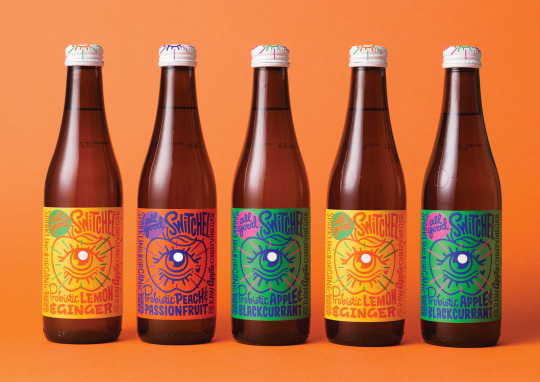
Based in the city of Auckland, on New Zealand’s North Island, AKIN is a strategic design studio co-founded by designers Tana Mitchell and Emma Kainuk. Their work aims to grab people’s attention and hearts and they achieve this through creating engaging brands with memorable type, eye-catching colour and gorgeous illustration. Their design for All Good Switchell, a collaboration with illustrator Natasha Vermeulen, is all these things—and we love it!
2. Seachange
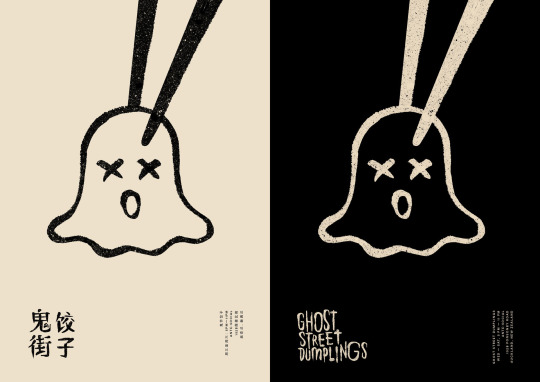
Also based in Auckland, Seachange are an award-winning design and branding studio—they work across everything from digital design to naming and everything in between. Keeping themselves intentionally small doesn’t stop Seachange creating a big impact—their brands stand out for a whole variety of different reasons. One such brand is Ghost Street Dumplings, a pop-up dumpling, which used the company’s name very literally combined with a cute illustration to create a wonderful, memorable brand.
3. Tyrone Ohia
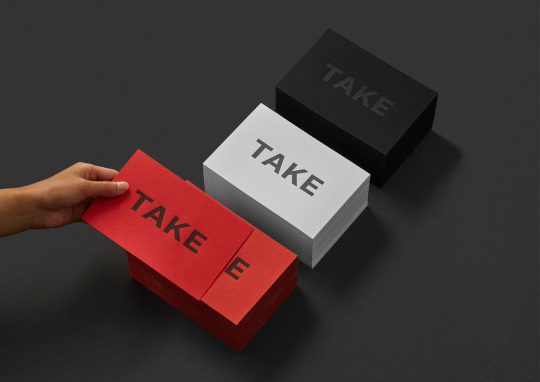
Born of Ngāti Pūkenga (a Māori Iwi) descent in Tauranga, a harbourside city on the North Island, Tyrone Ohia works as a Creative Director in Tāmaki Makaurau (the Māori name for Auckland). Ohia believes that design is for the people and this is strongly reflected throughout his work. His project for the Museum of New Zealand Te Pape Tongarewa reflects on the fact that the Māori and English languages share the same alphabet and words through the word ‘TAKE’. He designed simplistic, yet beautiful, cards with the word simply printed on there for people to take away and consider the similarities between the two languages.
4. Curious

Another Auckland-based agency, Curious specialises in design and brand strategy. Working with their motto ‘Good design is simple—that’s why it’s so hard to get right. It helps that we’ve been practising constantly since 1998’, Curious work closely with their clients to create the best work possible. Their project for health food brand Amino Mantra combined quirky illustrations from Curious’ in-house illustrator Curtis Walker and a gorgeous colour palette to create the kind of packaging you just want to grab off the shelf.
5. Phoebe Morris
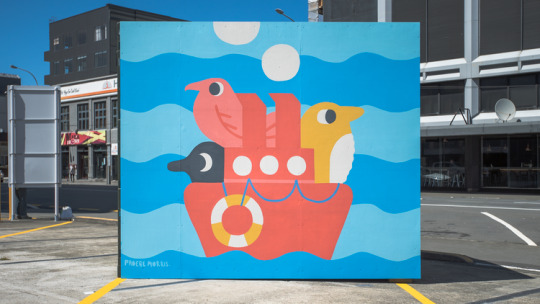
Phoebe Morris is a illustrator from New Zealand’s capital city, Wellington. Since graduating in 2013, Morris has worked with companies like Google, Penguin Books and Kiwibank—illustrating for, to name a few, apps, websites, packaging, publications and shipping containers. The last was what made us especially fall for Morris’ work—she was commissioned by Wellington City Council in September 2018 to paint local birds on shipping containers on the city’s waterfront. They depict the cute critters in a number of activities that visitors can take part in at the waterfront.
6. Frances Haszard
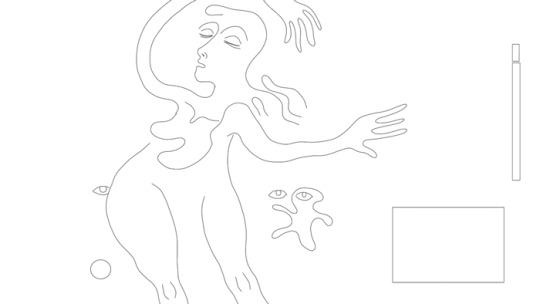
Frances Haszard is an animator from Auckland who creates alluring, quirky and often outright weird animations. She’s worked on music videos for musicians like Two Door Cinema Club and drummer Julien Dyne. Though Haszard often using dazzling colours and 3D graphics in her work, we were struck by her animation for Hera Lindsay Bird’s ‘Children are the Orgasm of the World’—which, instead, uses simple black line animation on a white background to striking effect.
7. Klim Type Foundry

Founded in 2005 by Kris Sowersby, a New Zealand typeface designer, Klim Type Foundry is a type foundry based in Wellington. The world-renowned type foundry produces custom typefaces for businesses around the world, retail typefaces and custom lettering and logotypes. We love his typeface Geograph—a typeface designed for National Geographic as part of their rebrand in 2016. It’s a contemporary, plain sans serif that is made up of 24 different styles that the company uses across their broadcast, print and web channels.
8. Salted Herring

Salted Herring, based in Wellington, is a digital design consultancy and agency who specialising is SaaS (Software as a Service for those who don’t know!) who specialise in digital products. They not only develop identities and create websites for brands—they do UX design, UI design, data visualisation, strategy, front end development and loads more. Kōkako is an app that measures the use of the Māori language on the radio across the country, Salted Herring delivered the strategic creative, visual identity, UX and UI design and the front end development. The app combines cutting edge technology, created by Dragonfly Data Science, and contemporary design to promote the country’s first language.
9. BrandAid

BrandAid is a brand development and design agency based in Dunedin on New Zealand’s South Island. The award-winning agency’s creative director Luke Johnston has over 19 years experience in the industry—and founded BrandAid 15 years ago. They’ve worked with a huge range of clients, including their home city but it was this reusable packaging for Bay Rd Peanut Butter—which employs striking typefaces to make the look as good as it is for the planet.
10. Pete McDonald
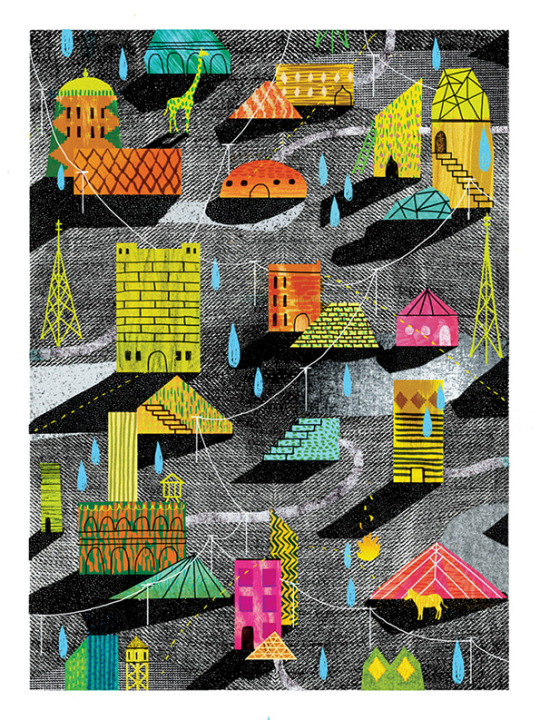
Pete McDonald is a Christchurch-based freelance designer, illustrator and animator who has created a massive and massively varied body of work. He’s worked with some of the biggest companies in the world including Google, Nike, Converse, Sundance Film Festival and Coca Cola. Though, it was this illustration from his work for Unicef East Africa Appeal that caught our eye—pattern, colour and shape are combined to make this illustration an absolute treat for the eyes!
0 notes